7 FUN FALL EVENTS THRIFTED BACK-TO-SCHOOL WARDROBE
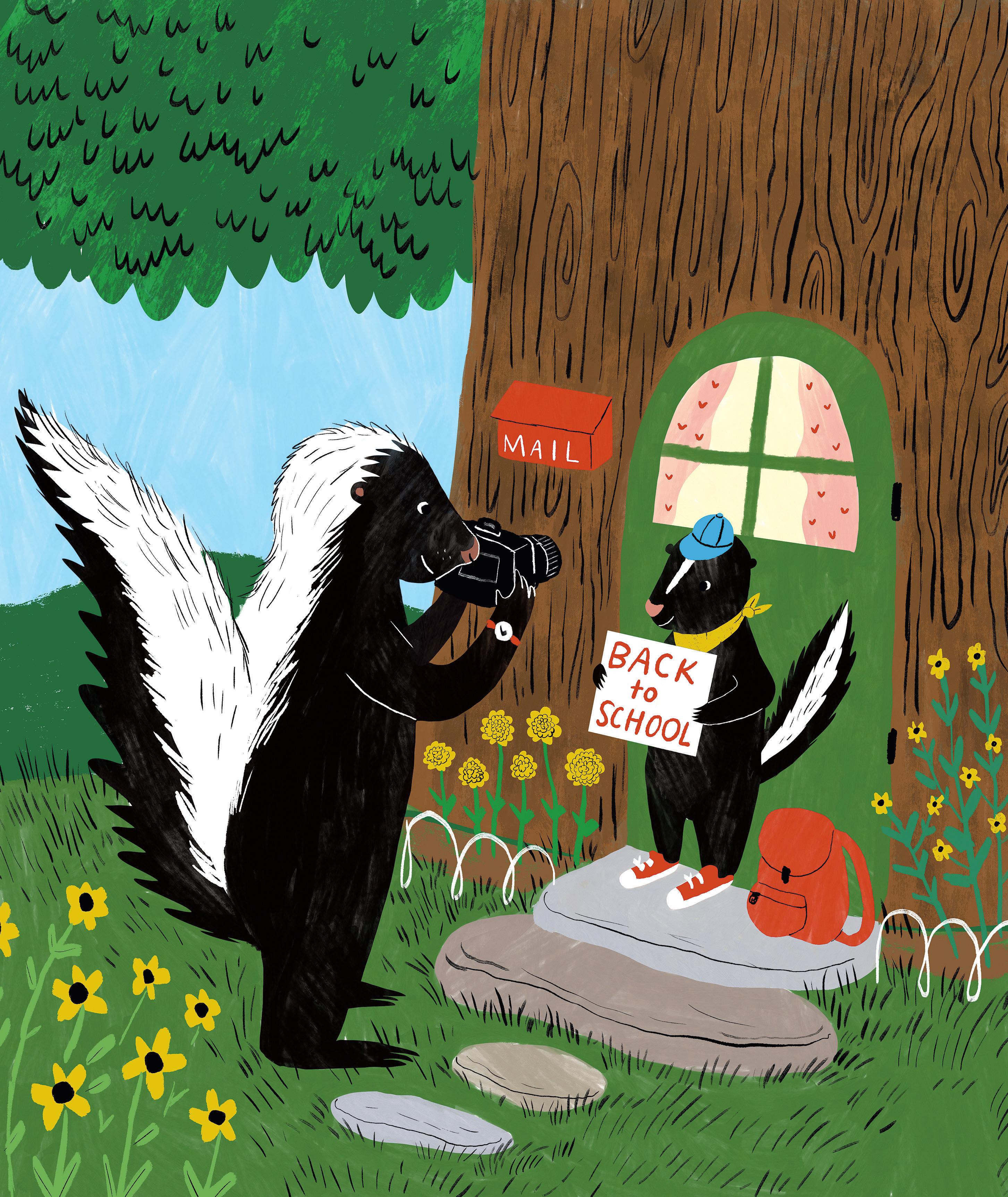
STUDENTS’ TAKES ON PHONE-FREE SCHOOLS GOOD CITIZEN HALL OF FAME







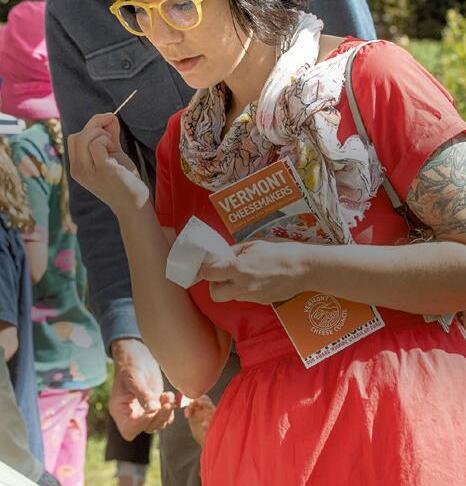





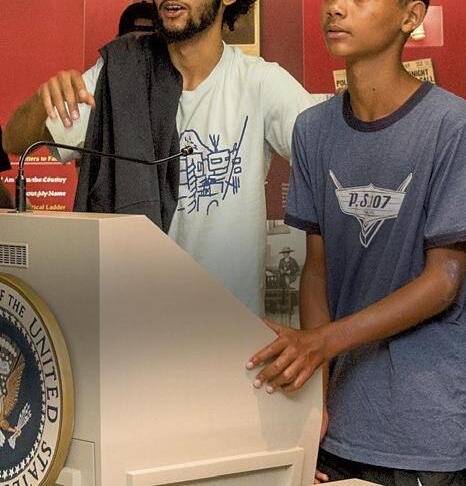
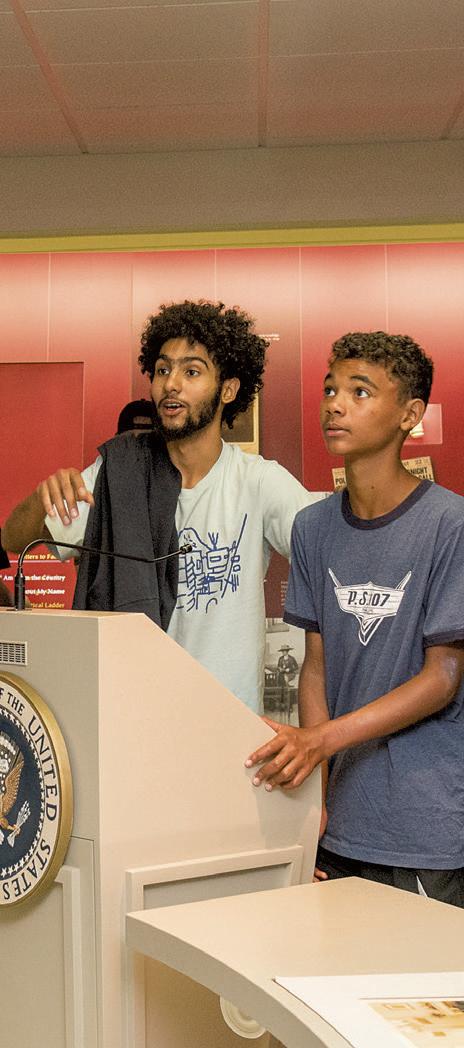






















STAFF & CONTRIBUTORS
COPUBLISHER
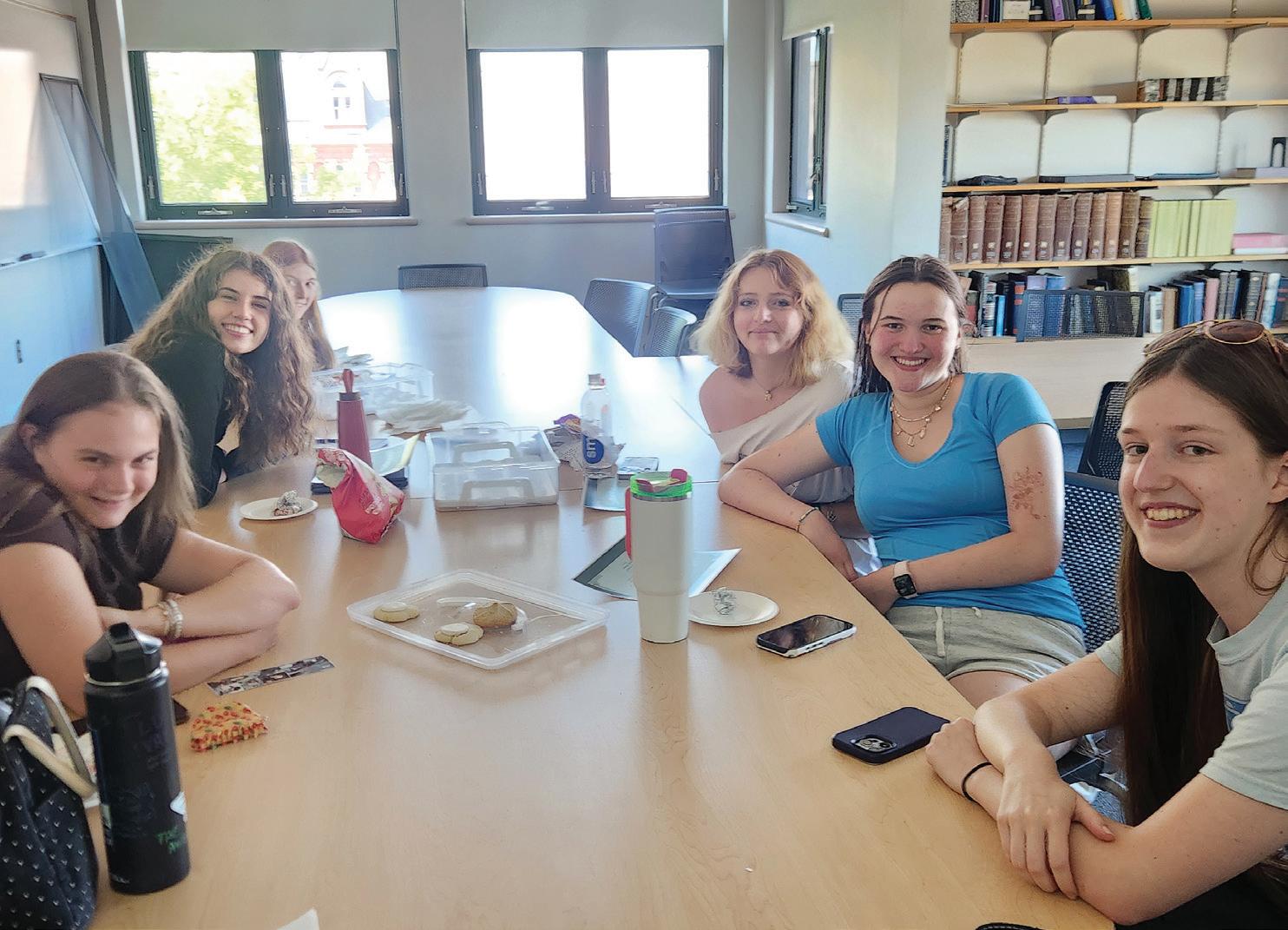

7 FUN FALL EVENTS THRIFTED BACK-TO-SCHOOL WARDROBE

STUDENTS’ TAKES ON PHONE-FREE SCHOOLS GOOD CITIZEN HALL OF FAME





































COPUBLISHER

This year’s Back-toSchool Issue of Kids VT was written almost entirely by young people.
Contributors include Seven Days summer interns Sam Hartnett, Anthony Cinquina and Madeleine Kaptein. The latter two came to us from Middlebury College, through the school’s MiddWorks internship program. Sam graduated from the University of Vermont last May, and his tenure here was partially sponsored by UVM’s Center for Community News.
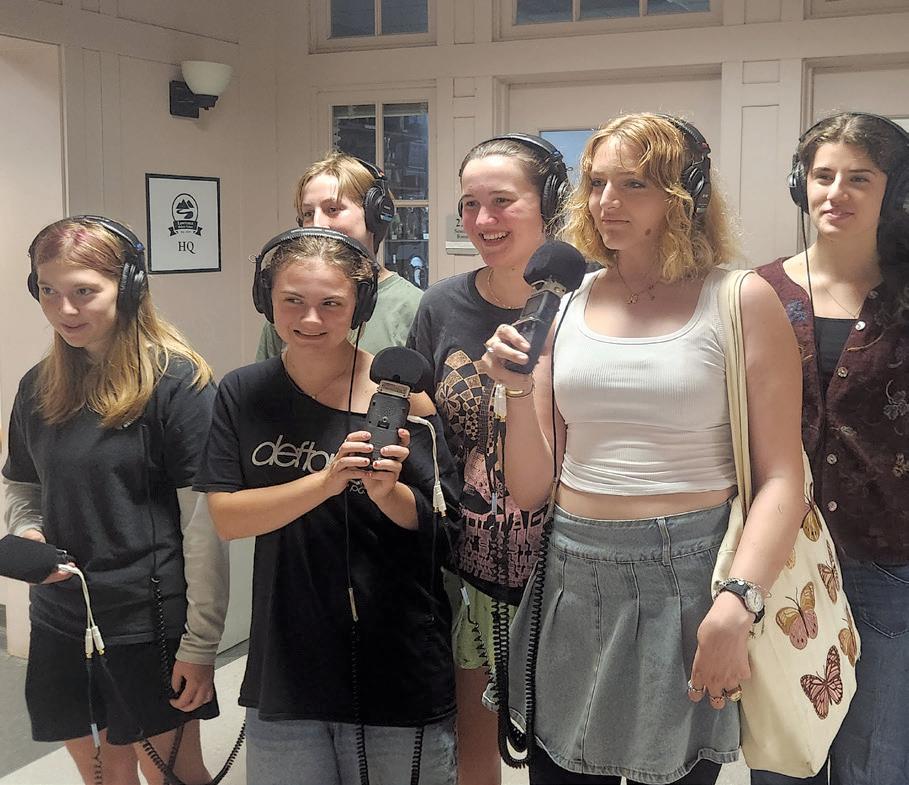
We’re also excited to showcase five articles produced by students in the new Green Mountain Summer Journalism Institute, founded and directed by Carolyn Shapiro. A lifelong newshound who’s now a freelance writer and editor, Carolyn has brought newbies into the profession as a journalism lecturer at UVM for the past three years. Full disclosure: She’s also married to Seven Days news editor Matthew Roy.

MONDAY
WEDNESDAY
THURSDAY
FRIDAY
P.O. BOX 1164 • BURLINGTON, VT 05401
802-985-5482 • SEVENDAYSVT.COM/KIDSVT
Published 4x per year.
Circulation: 43,000 at 1,000-plus
©
Editorial
Da Capo Publishing shall not be held liable to any advertiser for any loss that results from the incorrect publication of its advertisement. If a mistake is ours, and the advertising purpose has been rendered valueless, Da Capo Publishing may cancel the charges for the advertisement, or a portion thereof as deemed reasonable by the publisher. Da Capo Publishing reserves the right to refuse any advertising, including inserts, at the discretion of the publishers.
Carolyn was an editor for her high school newspaper in the Detroit suburbs when she got the chance to attend a summer journalism program at Northwestern University, her eventual alma mater. “Those six weeks on the shore of Lake Michigan, studying the art and craft of reporting and writing, got me hooked on journalism,” she wrote in an email.
She modeled some aspects of her program on that experience but also improvised — there was no internet back then. Her version included two weeks of in-person classes and hands-on training (interviewing people in downtown Burlington, for example); talking with working journalists; and trying audio recording at UVM and video production at CCTV Studios. Then the students spent two weeks at home coming up with stories that mattered to them, reporting them, workshopping them virtually with editors and, finally, going through the last stage of polishing at Kids VT
Tuition for this first summer session was free; Carolyn covered any expenses. She also enlisted volunteer editors who helped shape the student stories: Anna Hoppe, 20, a junior at the University of Vermont studying environmental sciences; Cecilia Luce, 19, a sophomore at Northwestern University pursuing a double major in journalism and environmental sciences; and Rose Howell, a senior at Burlington High School and coeditor-in-chief of its student newspaper, the Register
At a time when Americans are turning to partisan podcasters, influencers and AI summaries to get their news, it’s refreshing and inspiring to see young people finding local stories and striving to get them right. Parents, we hope you appreciate their efforts as much as we do — and savor this beautiful fall season!
CATHY RESMER




















































































Phone Free-for-All
Students sound off on new statewide cellphone ban
Art of the Thrift
A teenage back-to-school shopper gets more bang for her bucks at secondhand stores
Help Wanted
Navigating family, school and work can be tricky — for teens and their bosses
Thrill of the Chase
Young Vermonters talk about how they learned to hunt and why they love it
Alzheimer’s Association brings old and young together for a cause
Selections from the 2025 Good Citizen Challenge Hall of Fame










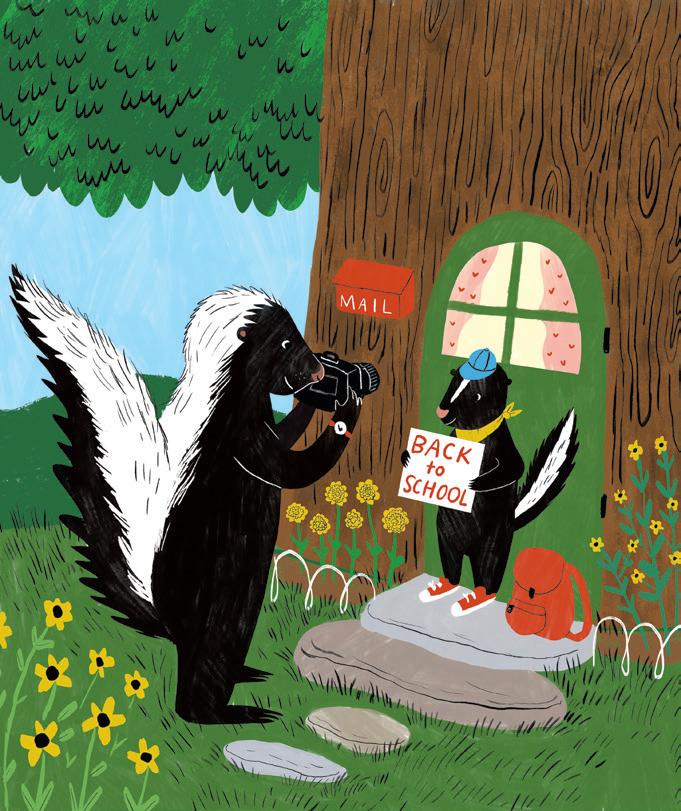





















BY REBECCA DRISCOLL



SEPTEMBER 11-14
The TUNBRIDGE WORLD’S FAIR first delighted Green Mountain guests in 1867 and has stayed strong through more than 150 years of cultural shifts and technological advances. This year’s festivities strike the perfect balance between 19th-century living and modernity with a vast and varied lineup, including fiber crafting demos, pony pulling, dairy animal judging, the Silver Circus Show and a live performance by country music sensation Jamie Lee Thurston.

The Queen City’s annual Art Hop celebration isn’t just for grown-ups! Mini art lovers find much to do at KIDS HOP, a pint-size subset spanning venues across Burlington’s South End Arts District. Crafty activities ranging from Fourbital Factory’s “Design a Beanie” contest to live screenprinting demos at Amalgamated Culture Works hold wee ones’ attention while the adults get their creative fix, too.
Friday, September 5, through Sunday, September 7, at the South End Arts District in Burlington. Free. Info, outreach@seaba.com, seaba.com.
SEPTEMBER 20
The MISSISQUOI WILDLIFE FAIR invites environmentally minded families to “Dig Into Nature”at the Missisquoi National Wildlife Refuge in Swanton. Critters, crafts and critical information abound with a power-packed schedule of expert presentations, guided hikes, birdhouse painting, scavenger hunts — and even owl pellet dissections for curious little scientists.
Thursday, September 11, 7 a.m.-8 p.m.; Friday, September 12, and Saturday, September 13, 7 a.m.-9 p.m.; and Sunday, September 14, 8 a.m.-5 p.m., at the Tunbridge World’s Fairgrounds. $10-50; free for children under 12. Info, info@tunbridgeworldsfair.com, tunbridgeworldsfair.com.







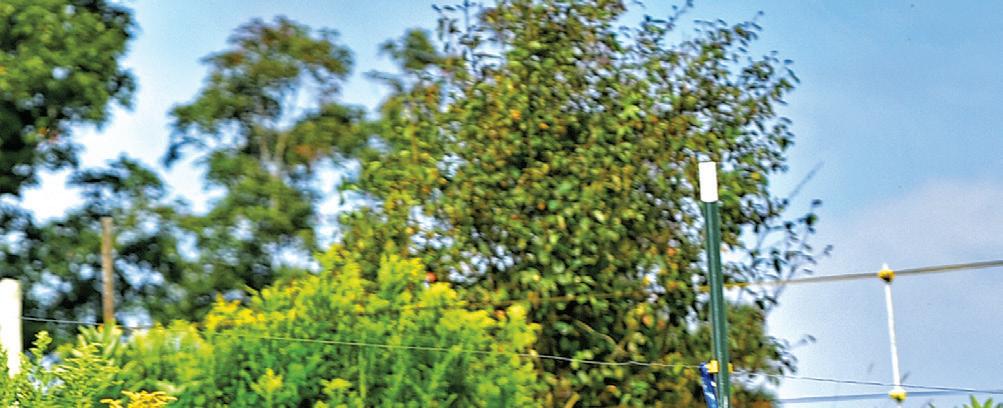
OCTOBER 25

Rein It In
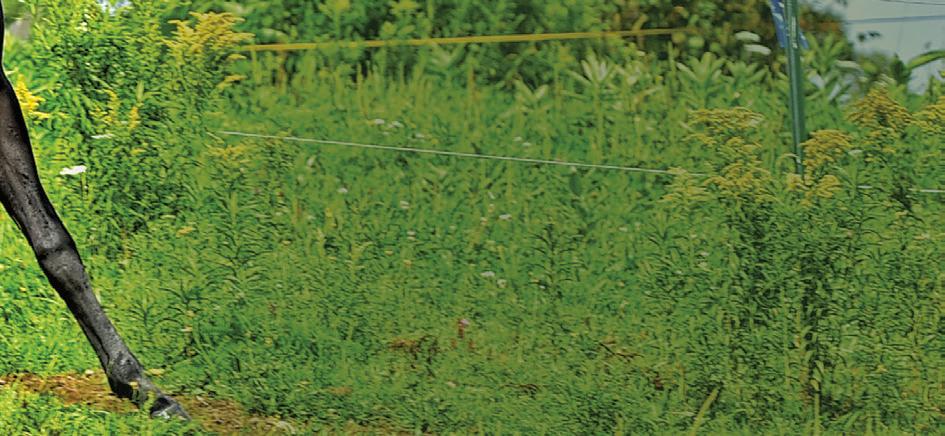

The University of Vermont Morgan Horse Farm beckons equine enthusiasts of all ages to the majestic DAY OF THE MORGAN in Weybridge. The horse-powered day pays homage to the friendly, intelligent breed with fun and educational o erings, including guided tours, historical displays, walking trails, a ra e, and the unbeatable fall pairing of cider and doughnuts.
Saturday, October 25, 10 a.m.-2 p.m., at the University of Vermont Morgan Horse Farm in Weybridge. Free. Info, 388-2011, uvm.edu.


Saturday, September 20, 10 a.m.-3 p.m., at the Missisquoi National Wildlife Refuge in Swanton. Free. Info, info@friendsofmissisquoi.org, friendsofmissisquoi.org.
SEPTEMBER 23 & 24
Get ready to laugh, cry and say helloooooooo! when MRS. DOUBTFIRE entertains audiences at the Flynn Main Stage in Burlington. Based on the iconic 1993 film starring Robin Williams as everyone’s favorite Scottish nanny, the acclaimed stage production tells the tale of one outof-work dad’s unwavering mission to be with his kids. As the Chicago Tribune raves, it’s “the lovable, big-hearted musical comedy we need right now.”
Tuesday, September 23, and Wednesday, September 24, 7:30 p.m. at the Flynn Main Stage in Burlington. $36-100. Info, 863-5966, flynnvt.org.
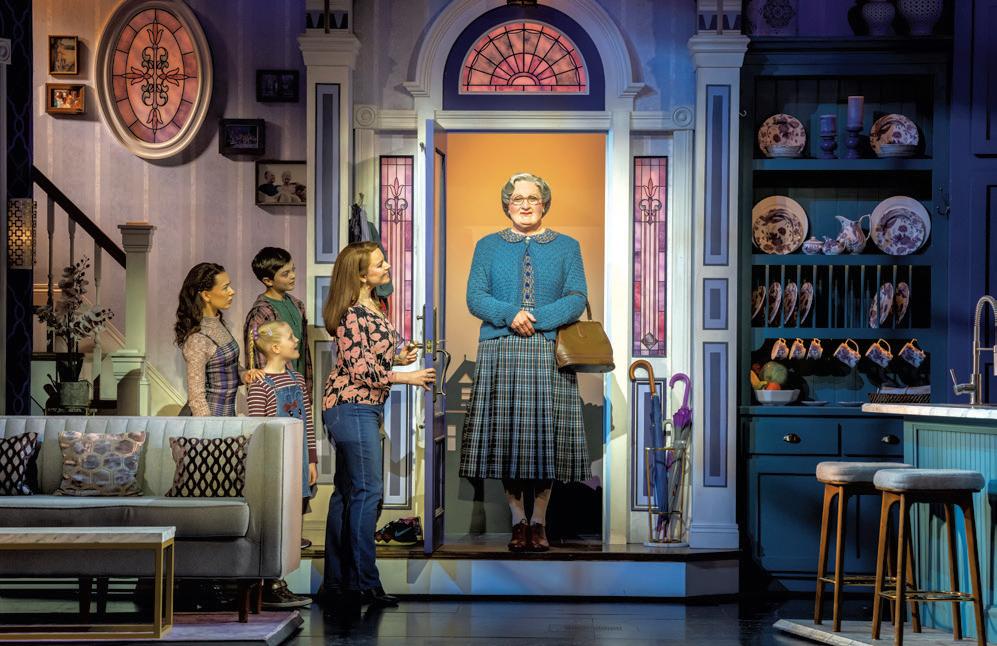
SEPTEMBER 27
Did someone say pony rides? You bet your autumn dollar! The annual BURKE FALL FESTIVAL delivers peak cozy-season vibes to revelers in East Burke Village with a day of unbeleafable entertainment. A parade kicks o six stacked hours of barbecue, face painting, horse-drawn wagon rides, a craft fair, a petting zoo, rubber ducky races — and even cow plop bingo. (It’s the Vermont way!)
Saturday, September 27, 9 a.m.-3 p.m., at various East Burke Village locations. Free. Info, 626-4124, burkevermont.com.
OCTOBER 25 & 26
“This is Halloween; everybody make a scene!” Rotary Park lights up with spooky sights and seasonal delights at HALLOWEEN IN WINOOSKI, a haunting holiday bash showcasing 1,000 jack-o’-lanterns crafted by local hands, ghoulish carnival games, a photo booth for capturing all those creative costumes and a frightfully fabulous lineup of live music.
Saturday, October 25, and Sunday, October 26, 10 a.m.-2 p.m., at Rotary Park in Winooski. Free. Info, info@downtownwinooski.org, downtownwinooski.org.





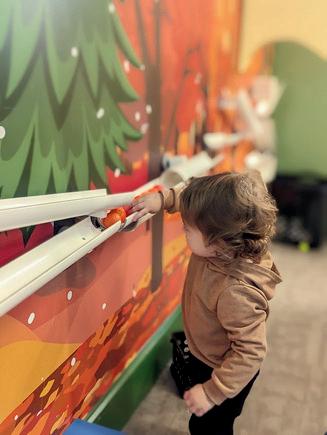

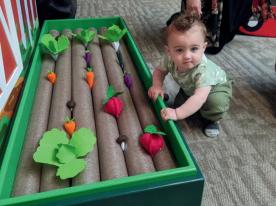



Parenting and caregiving advice may be all over the internet, but the opportunity to learn those skills in depth from professionals is rarer and far more valuable. Prevent Child Abuse Vermont o ers 12-to-14week courses on nurturing tailored to various family situations. Many begin in late summer or early fall.
In “Nurturing Skills for Families,” parents, especially of children through age 11, learn to strengthen family bonds and build a healthy home environment. Participants work on self-awareness, self-worth and empathy to apply to family situations. “Strengthening Families With Children Birth to Age 3” provides guidance to parents of younger children by teaching skills such as using rewards, solving problems and setting limits with their kids.

models. Meanwhile, the “Nurturing Fathers Program” is all about male nurturance, with a new focus each week — how to play with children, deal with cultural influences on parenting habits and handle feelings are a few.
With a small group of eight to 10 parents in each class, participants have said they’ve felt increased confidence and had stronger relationships with their children after taking the courses, family support programs director Michelle Richling said. She noted that among the many reasons to o er the programs is to “prevent abuse before it happens.”
Learn more at pcavt.org/ nurturing-parents.
MADELEINE KAPTEIN
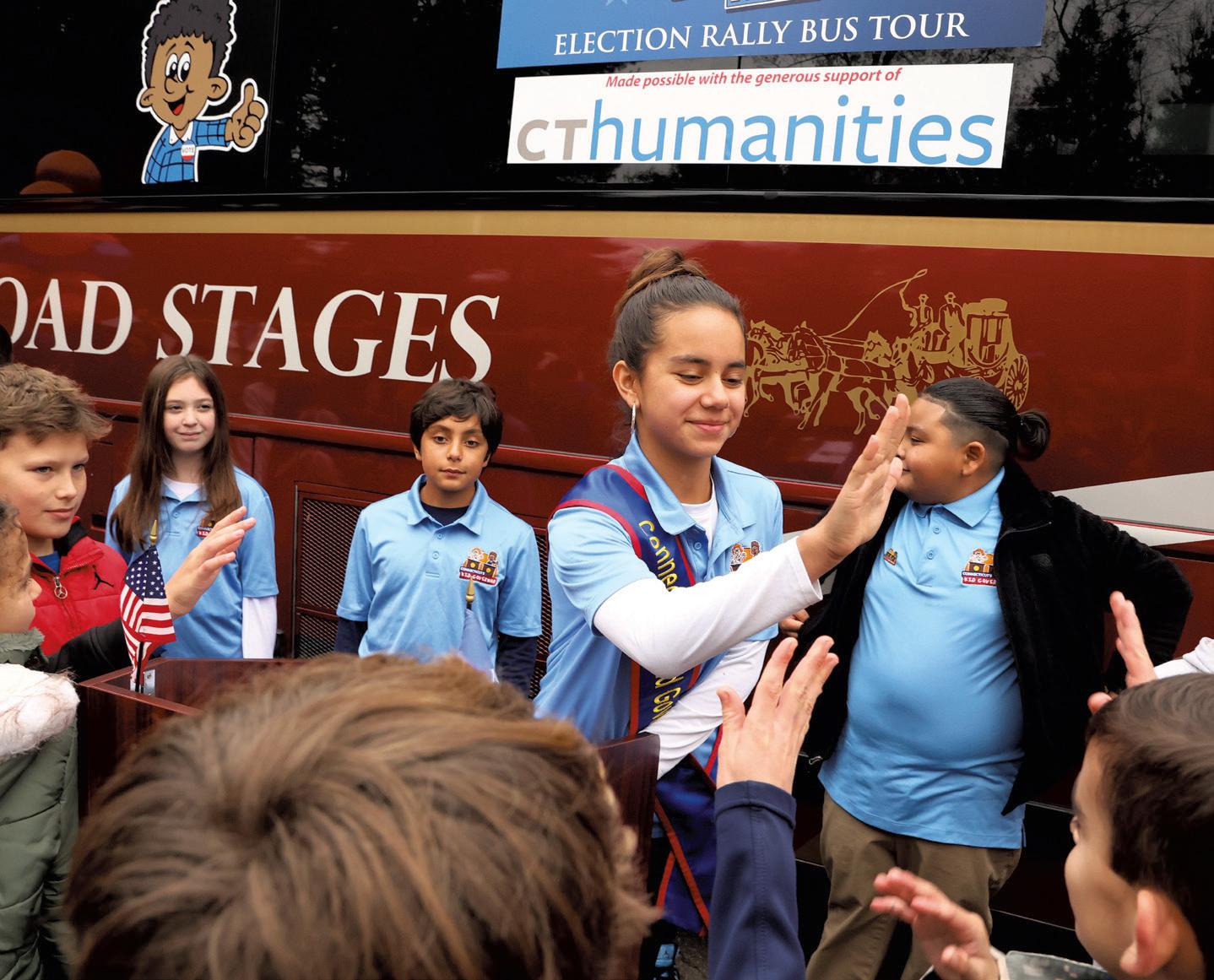

Vermont will have a new governor this fall, and it’s going to be a fifth grader.
The Secretary of State’s O ce, a partner on Kids VT’s Good Citizen Challenge, is o ering a new civics program called Vermont’s Kid Governor. Fifth-grade students from around the state will launch classroom campaigns vying for the top executive seat.
Each participating school holds a primary election to nominate one student to run for kid governor. Candidates make a three-point platform around an issue such as more walk-to-school days or more local food in the cafeteria. “The teachers will work with the kids to help design something that fifth graders can actually achieve,” Secretary of State Sarah Copeland Hanzas said.


voting process. It’s already spread to Nebraska, New Hampshire, Oklahoma, Oregon and now Vermont.
“One of the things about becoming a voter is understanding how to vote but also understanding how to evaluate the candidates who are on the ballot,” Copeland Hanzas said. She hopes kids will not only learn how voting works but also develop important skills that will help them be civically engaged as adults.


After the primary, each school’s candidate makes a video with their classmates. A committee of judges will use a rubric to score each video, and the top seven scorers will be on the final ballot. “One of those students will receive the most votes and become kid governor,” Copeland Hanzas said. The remaining six students still get to be involved; they’ll make up the cabinet.
Voting coincides with the actual election cycle, taking place in the fall. The seven candidates will have the opportunity to bus their classmates to the Statehouse for the inauguration in January.
The program started with the Connecticut Democracy Center in 2015, with the goal of teaching kids about the
The “Nurturing Program for Families in Substance Use Treatment and Recovery” is for parents transitioning to sobriety, many of whom are working to regain lost custody of their children. It helps participants become better role
Madeleine was a summer 2025 culture intern for Seven Days. A rising senior at Middlebury College majoring in comparative literature and minoring in history of art and architecture, she was the managing editor of the Middlebury Campus newspaper. Her writing has also appeared in the Addison County Independent





Pam Fallon, a fifth-grade teacher in St. Johnsbury, spearheaded the program’s spread to Vermont.
Her former class in Connecticut loved the program. She appreciated how teachers can decide how involved they want to get based on the class’ interest; they can just vote for kid governor, nominate one themselves or learn how to run a polling station. In Fallon’s Connecticut class, they even made campaign videos.
“It helped me to build that sense of democracy within the classroom, in not a bogus way — in a truly rigorous and relevant way,” Fallon said.
Find more information and learn how to get involved at vt.kidgovernor.org.
A recent graduate of the University of Vermont, Sam was a Seven Days news intern for summer 2025. He worked for the Community News Service as a Statehouse correspondent, covering agriculture, energy and environmental issues. Sam grew up in Montpelier and lives in Burlington.
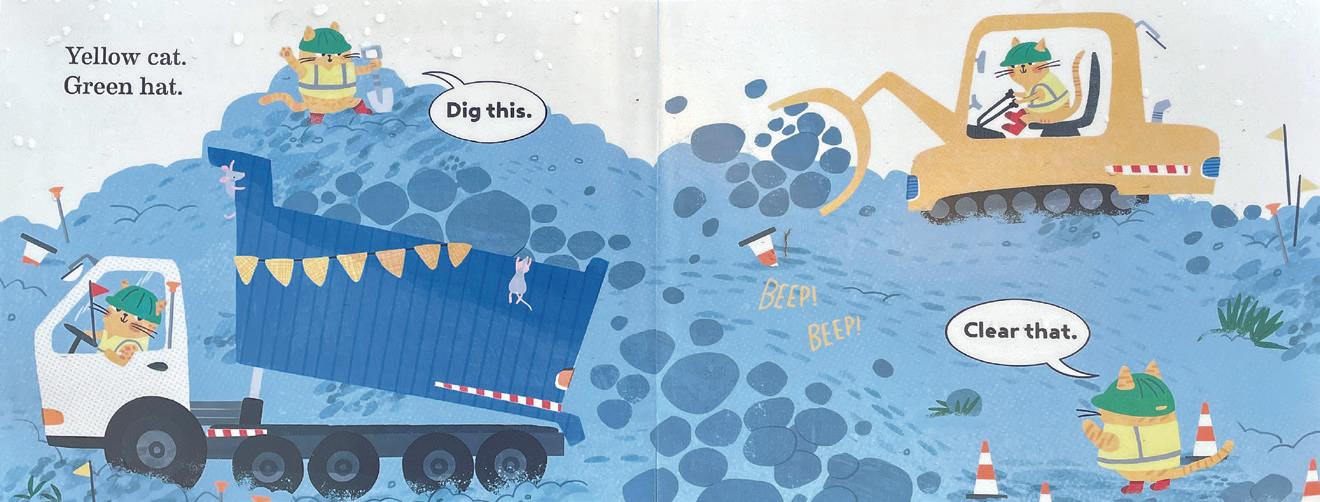
Construction projects under way in Burlington can make a city stroll feel like an obstacle course. The BTV StoryWalk, an activity launched by the Fletcher Free Library, takes advantage of the temporary fencing to entice families to explore downtown regardless — and get kids reading.
Participants pick up paper “passports” from the library’s main branch or the New North End branch and head to four di erent Burlington locations to read displays of children’s picture books. Stories at two of the four locations — the College Street Story Stroll and the Main Street Story Stroll — are installed on construction fencing, around the main library and between Piesanos and Nectar’s. The others are in Leddy Park and the main library’s front windows. In the latter, the book is Cats in Construction Hats by Sudipta
Bardhan-Quallen (pictured), continuing the construction theme.
“We’re embracing the construction instead of feeling sorry about it, because it’s going to be wonderful for the future. And kids love construction and love construction trucks,” said Gale Batsimm, Fletcher Free Library development manager.
Kids answer a simple question and turn in the completed passport at Lake Champlain Chocolates to receive a candy bar and enter a drawing for a family gift card to Ladybug Creative art studio.
The story strolls can also be completed electronically. Families log the activities through the Come Alive Outside app by taking pictures as they go, then show them at the main library youth desk for a Ben & Jerry’s cone coupon.
Learn more at fletcherfree.org/ storywalk.
WHITE RIVER JUNCTION, VT
k4t-TwinRiverUrology082025.indd 1
8/14/25 9:48 AM

SATURDAY





K4t-VtbrazilianJiujitsu082025.indd 1



Ti Haul Road Walk | 10:00 a.m.–12:00 p.m.
Follow the path the Ticonderoga took to get to the Museum from Lake Champlain to the Museum.
Artmaking | 10:30–11:30 a.m. and 1:00-2:00 p.m.
Artists of all ages can commemorate the day with their own Ti art.
Ti Talk with Richard Strum | 2:00–3:00 p.m. Ticonderoga: The Last of the Lake Champlain Steamers
Please
TiconderYOGA | 8:30–10:00 a.m.
Take a yoga class on the decks of the Ti.
Artmaking | 10:00 a.m.–1:00 p.m.
Artists of all ages make your mark on a shared art project commemorating the Ti
Listening Party with Vermont Folklife | 1:00–2:15p.m.
Come hear stories of the Ti and tell your own!
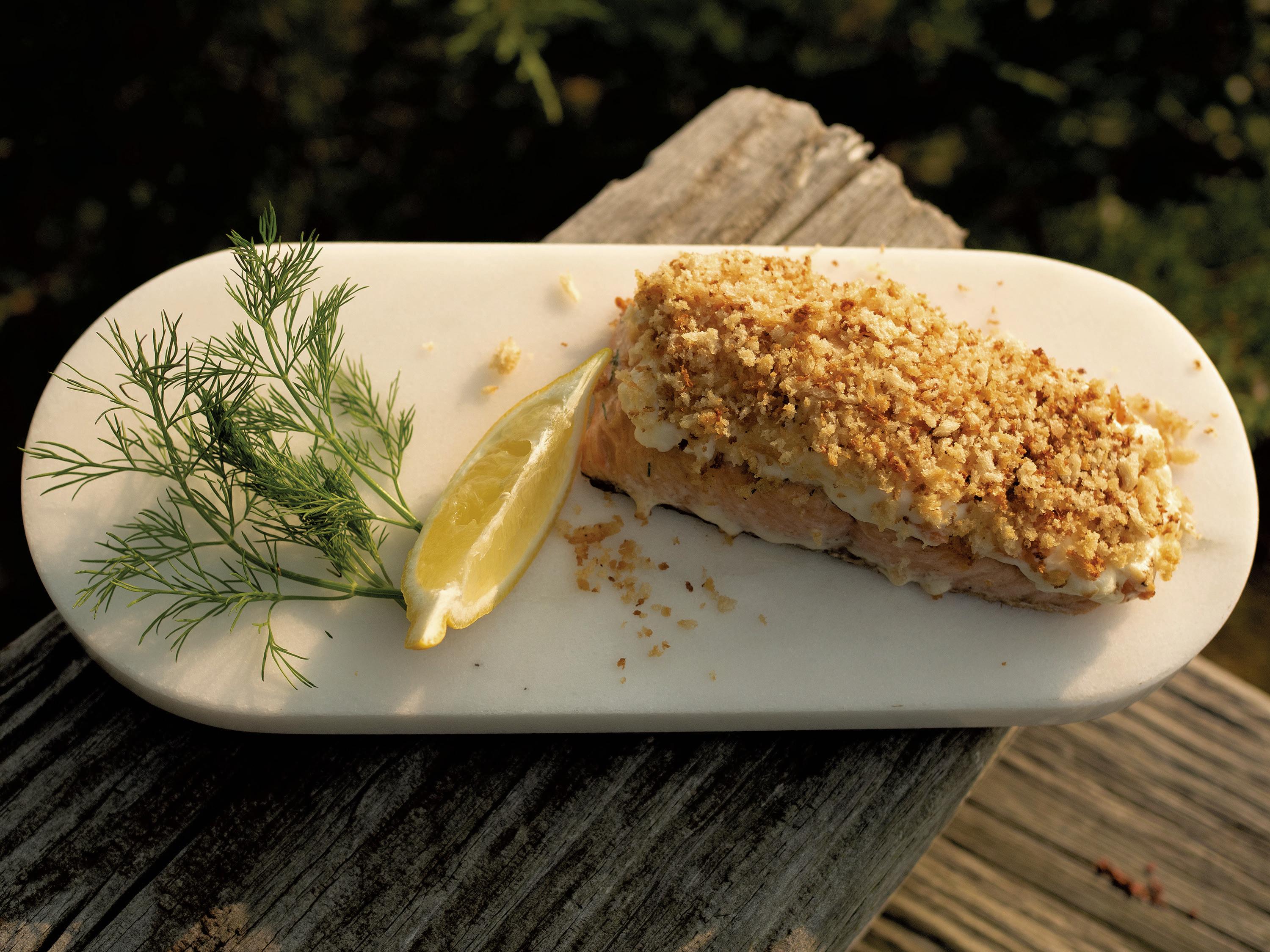
My husband and I wanted to go to Scotland for our honeymoon, but then the mad cow disease epidemic happened, and it didn’t seem like a romantic getaway to traverse the country with burning piles of cattle everywhere like a forbidden barbecue. We ended up going to Prague in the Czech Republic instead, and it was fantastic and unforgettable, but the dream of traveling to Scotland never left us.
This past spring, for our 25th anniversary, we finally made the trip. It was utterly astounding. Over 12 days, we saw 11 castles, three historic houses, 12 museums and other historic places, and seven Neolithic sites. We drove nearly 1,500 miles. Most of the Neolithic sites were on mainland Orkney, which is an island off the northeast coast of Scotland, reached via an hour-and-a-half ferry trip. We spent two days there and found the sites awe-inspiring — older than the Pyramids, full of so much history and stories we can mostly only guess at.
I think that through the years, Scotland (and the rest of the United
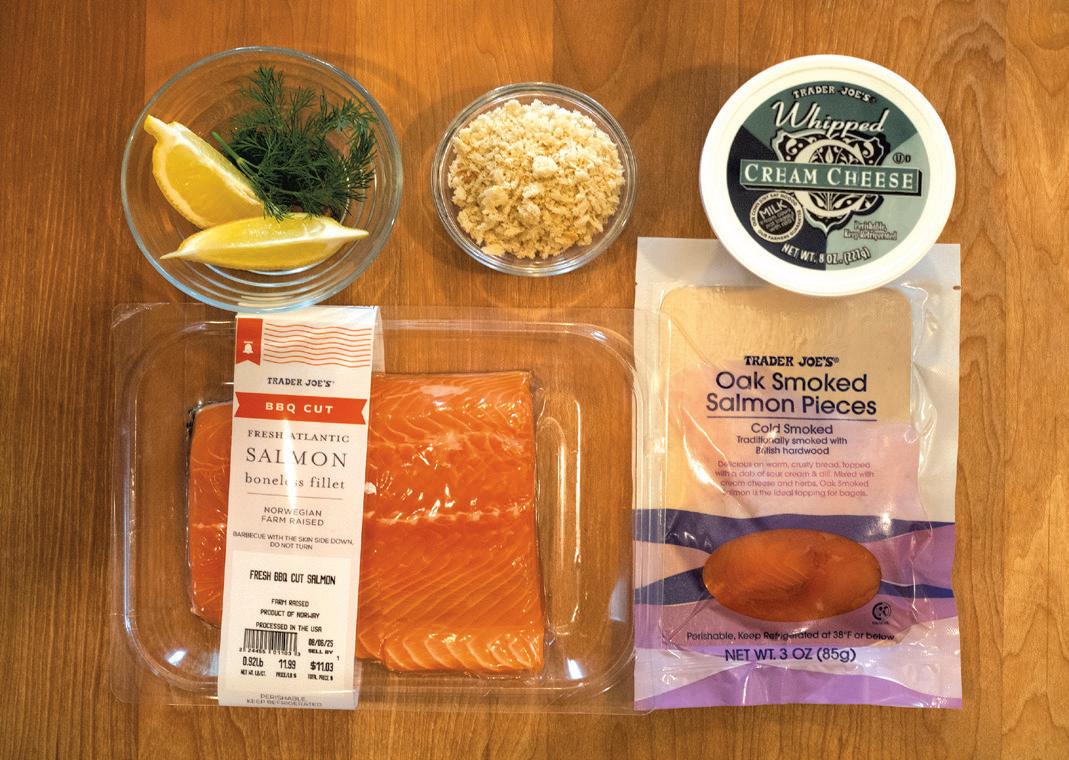
Kingdom) has gotten an undeserved bad reputation for its food. We had universally delicious meals on our trip. This dish is my version of my absolute favorite meal of the whole trip, at the Merkister Hotel, which our Airbnb hosts recommended for local eats. Always a fan of salmon, I saw a dish that had smoked salmon in cream cheese baked on top of a fillet of salmon … how could I resist?
• Juice of 1 lemon
Boneless skin-on salmon fillets (1 per person)
• 2 tablespoons fresh dill, finely chopped
• 4 tablespoons salted butter
• 1/2 cup panko breadcrumbs
• 1 small package smoked salmon
• 1 8-ounce container of whipped cream cheese
1. Preheat oven to 400° F.
2. Squeeze the lemon juice over the salmon fillets and sprinkle with dill. Let marinate for at least 10 to 15 minutes. (This can be done ahead of time; wrap and keep in the fridge until ready to use.)
3. Melt 1 tablespoon of butter in a small frying pan and toast the panko breadcrumbs over mediumhigh heat, stirring until lightly browned. Set aside.
4. Chop the smoked salmon into small pieces and stir into the whipped cream cheese. Set aside.
Since we got home, I have made this dish three times, and I’ll absolutely make it many times more. Quick and relatively simple, it’s still an impressive dish that you can be proud to share with company — or just enjoy with your family. The recipe does not use the entire amount of
smoked salmon cream cheese, so you have the bonus of extra for your bagels. I like using whipped cream cheese for this recipe because it is easier to mix in the smoked salmon. I also prefer salted butter, but keep in mind the smoked salmon can be a bit salty as you plan your sides.
We enjoyed it with roasted potatoes and a nice side salad. K
5. Melt remaining butter in a large sauté or frying pan. (Cast iron works great.)
6. Sear the salmon fillets in butter over medium-high heat for one minute, skin side down, then flip and sear for an additional 30 seconds. (The searing helps to keep the topping from sliding off the salmon.)
7. Transfer the salmon, skin side down, to a baking pan. (If your frying pan is large enough and oven-safe, you can leave the salmon in it, skin side down.)
8. Top each fillet with about 4 tablespoons of smoked salmon cream cheese, spreading with a spatula or a small piece of parchment paper to make sure the entire top is covered evenly.
9. Evenly coat the top of the cream cheese with panko breadcrumbs.
10. Bake for 10 minutes and serve immediately.

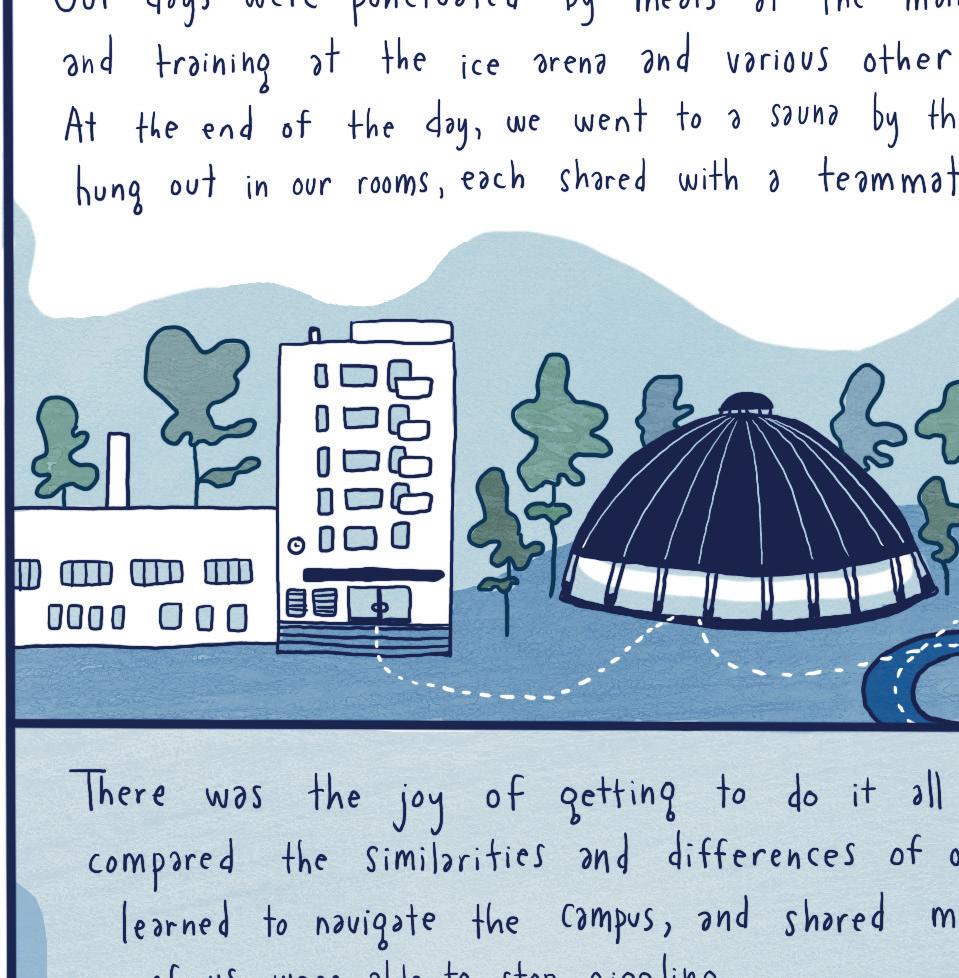

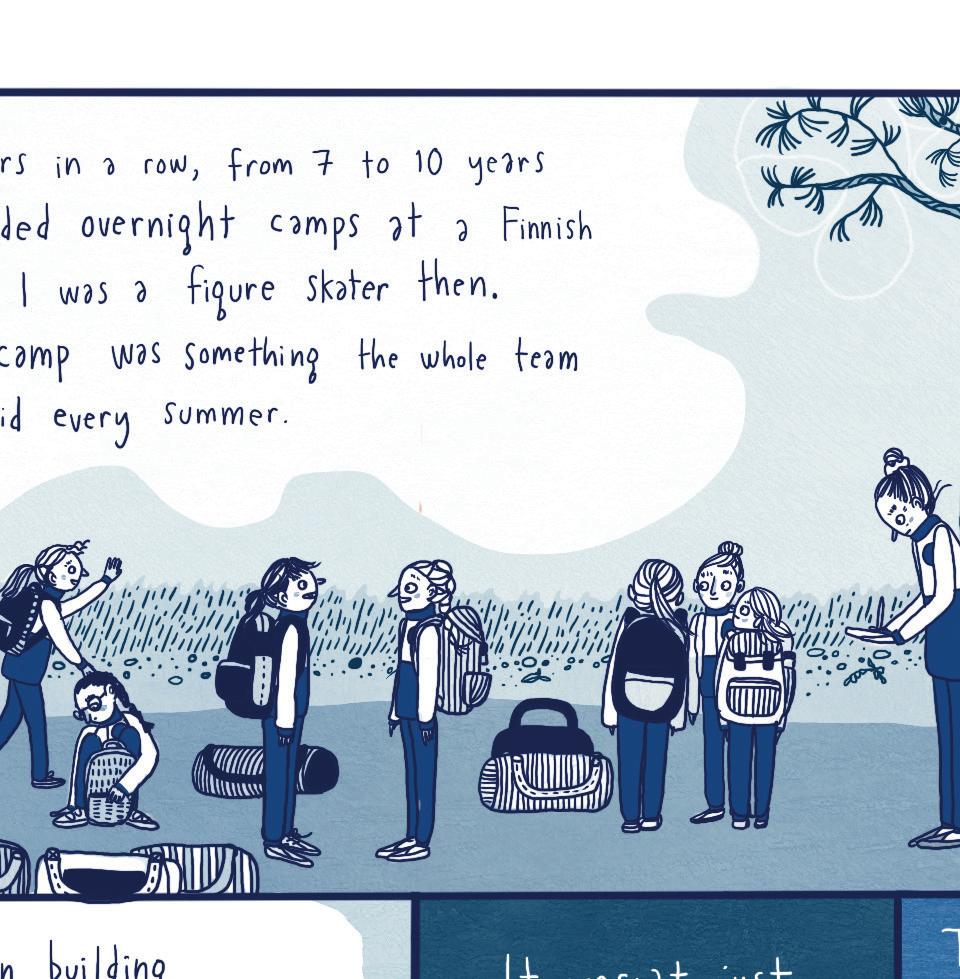




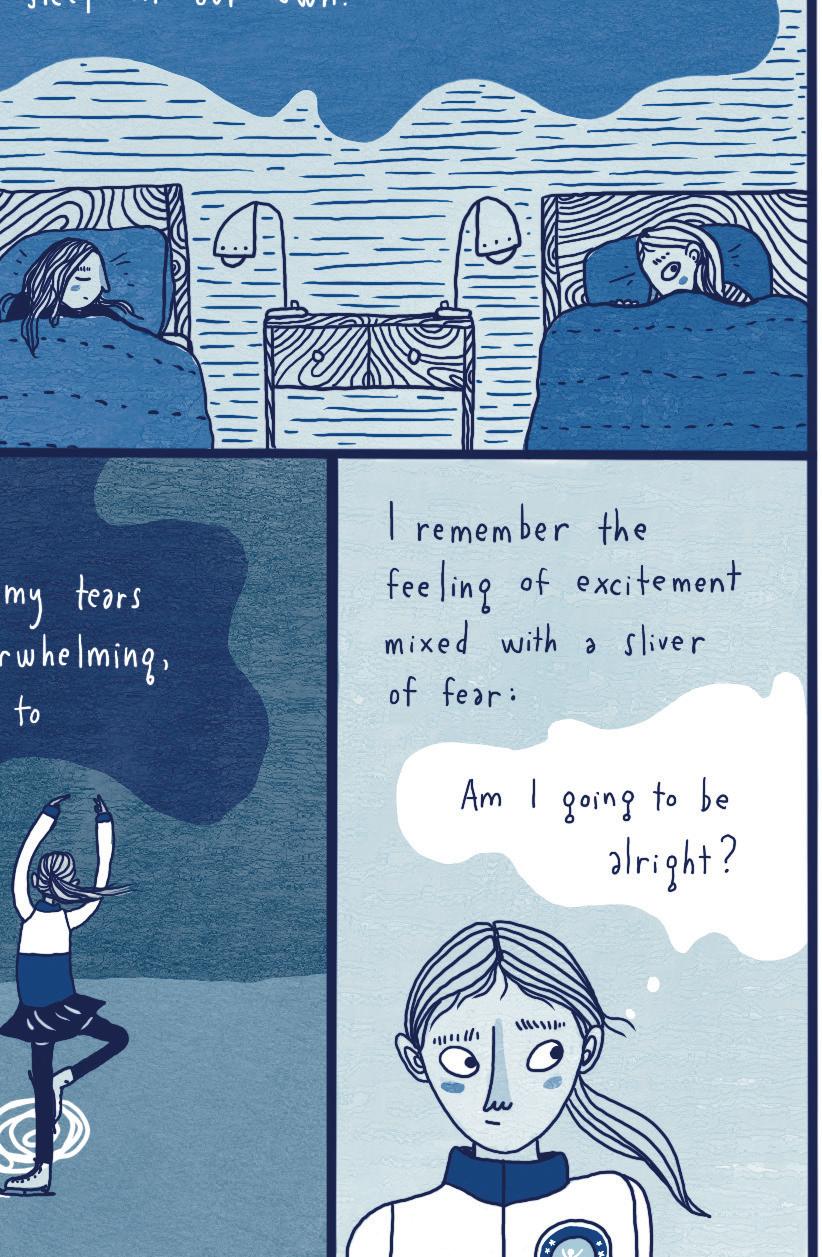

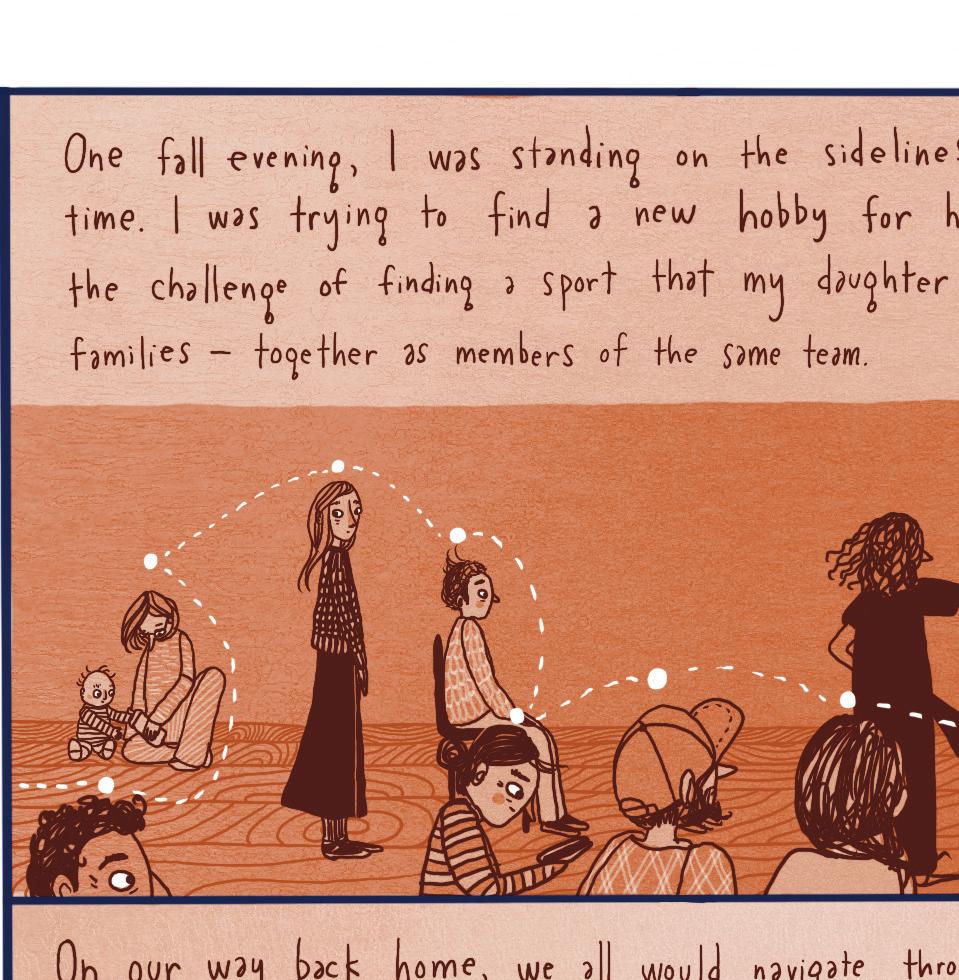
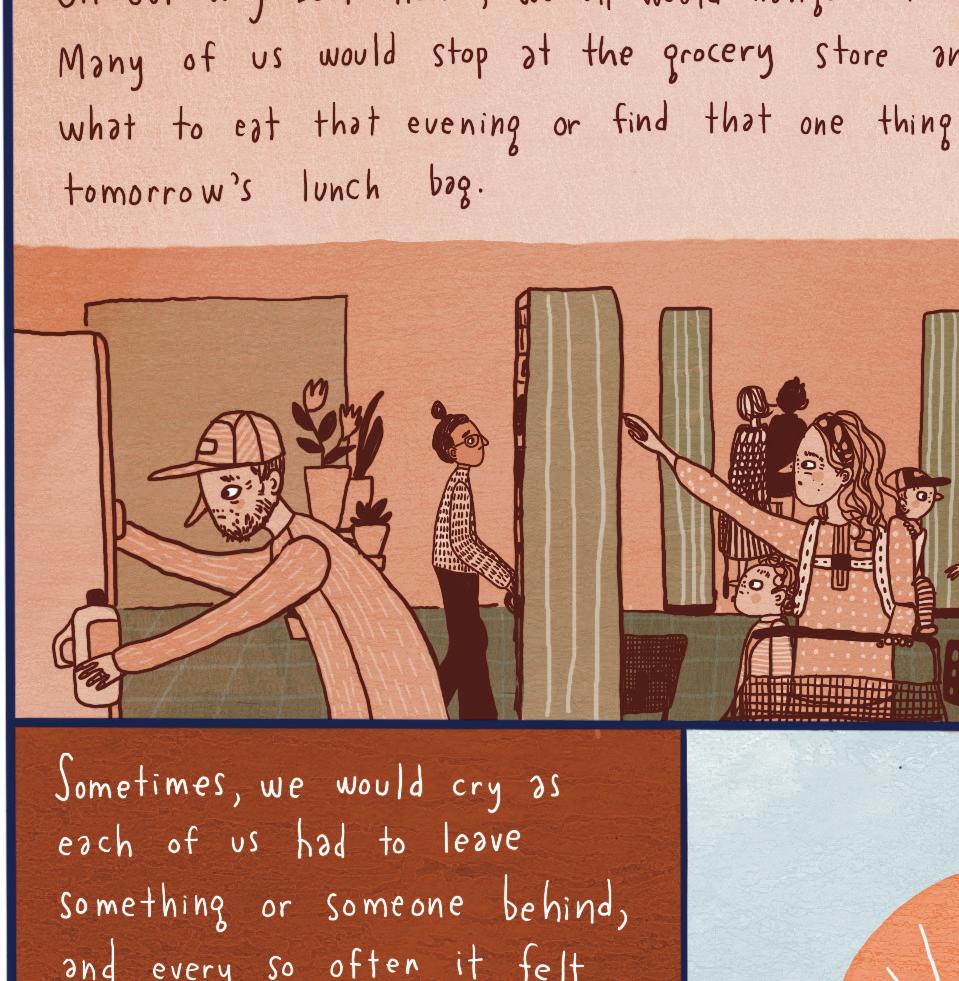
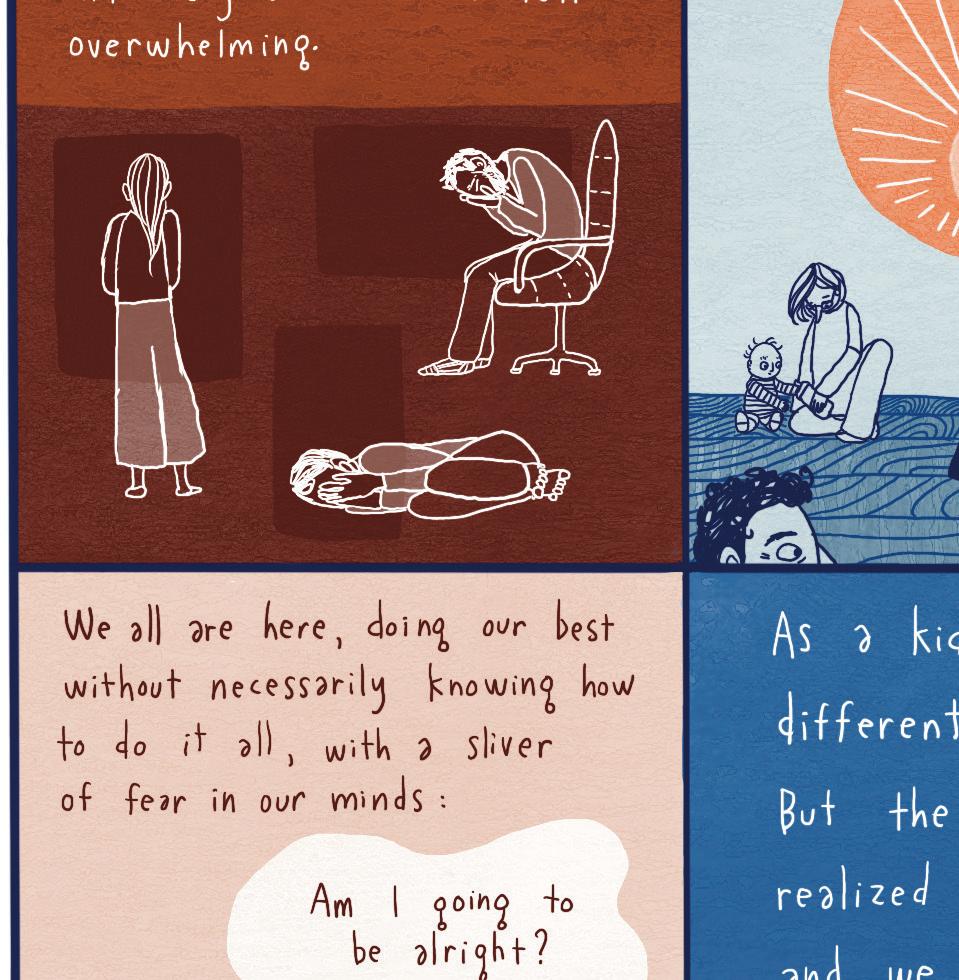
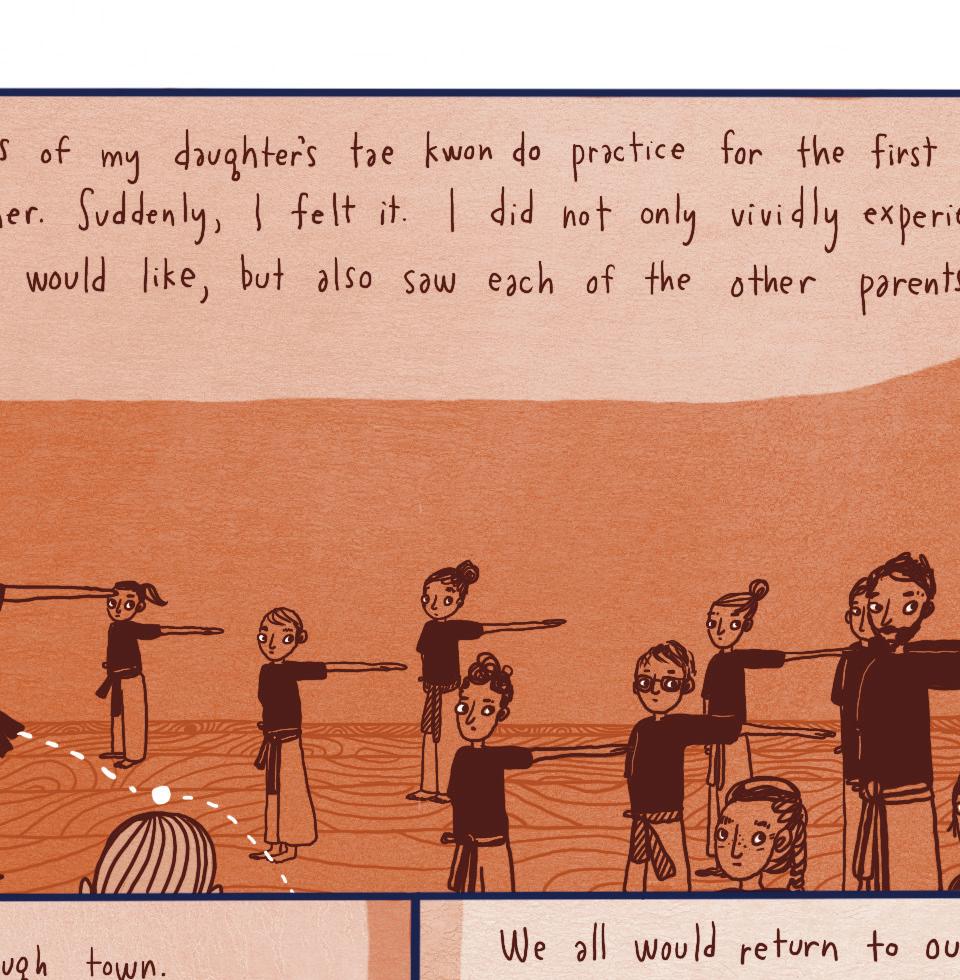

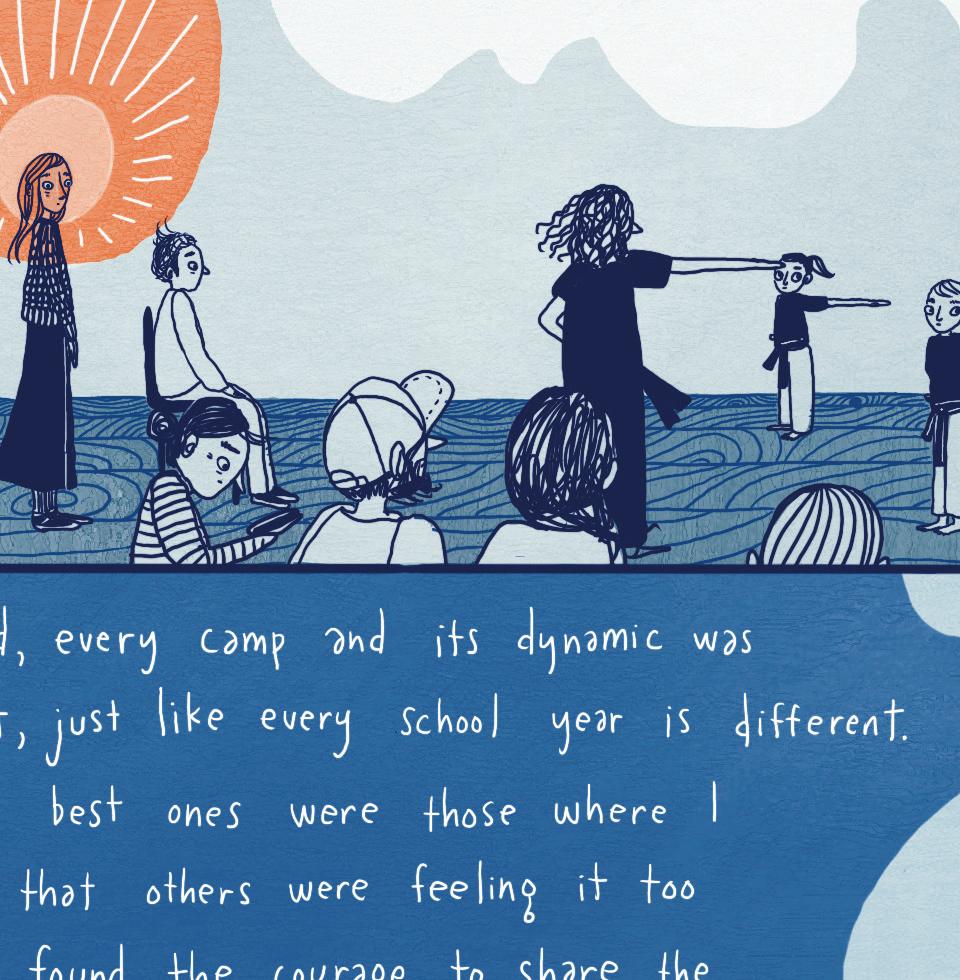

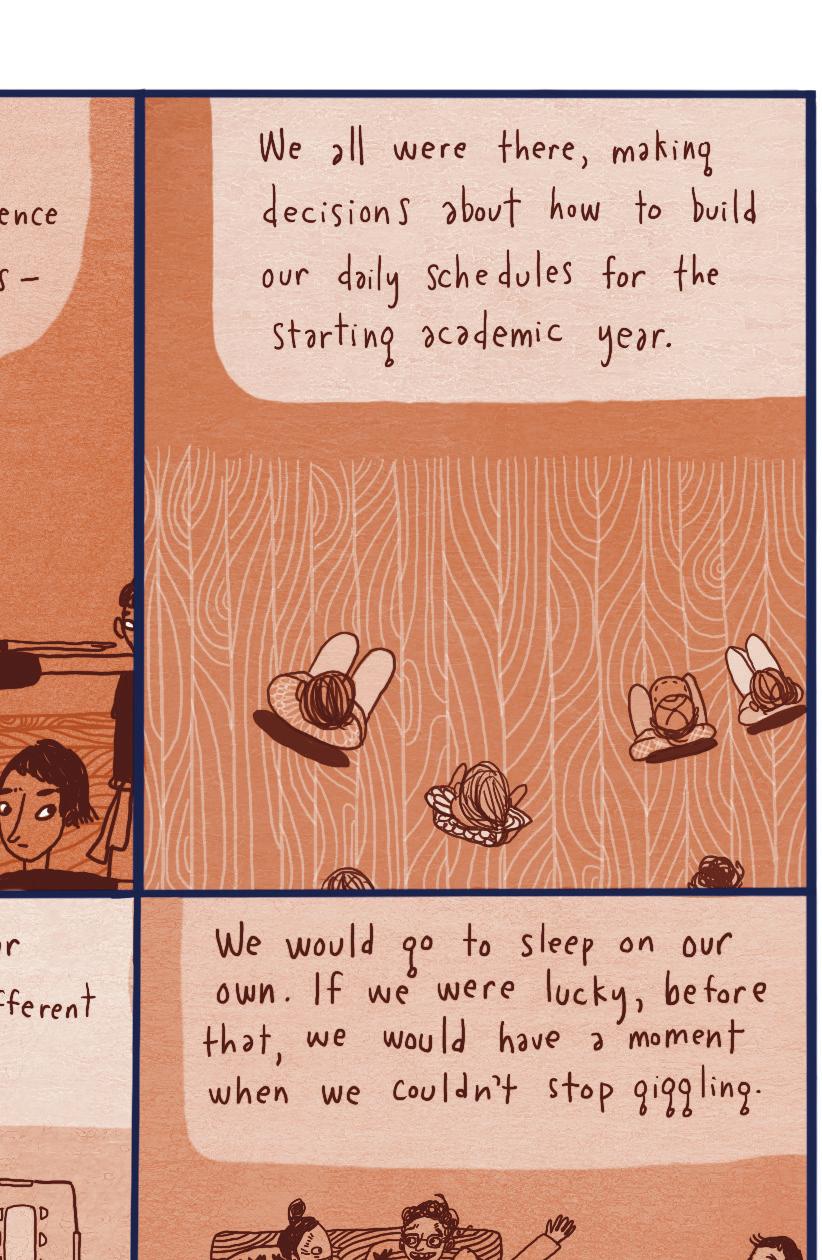
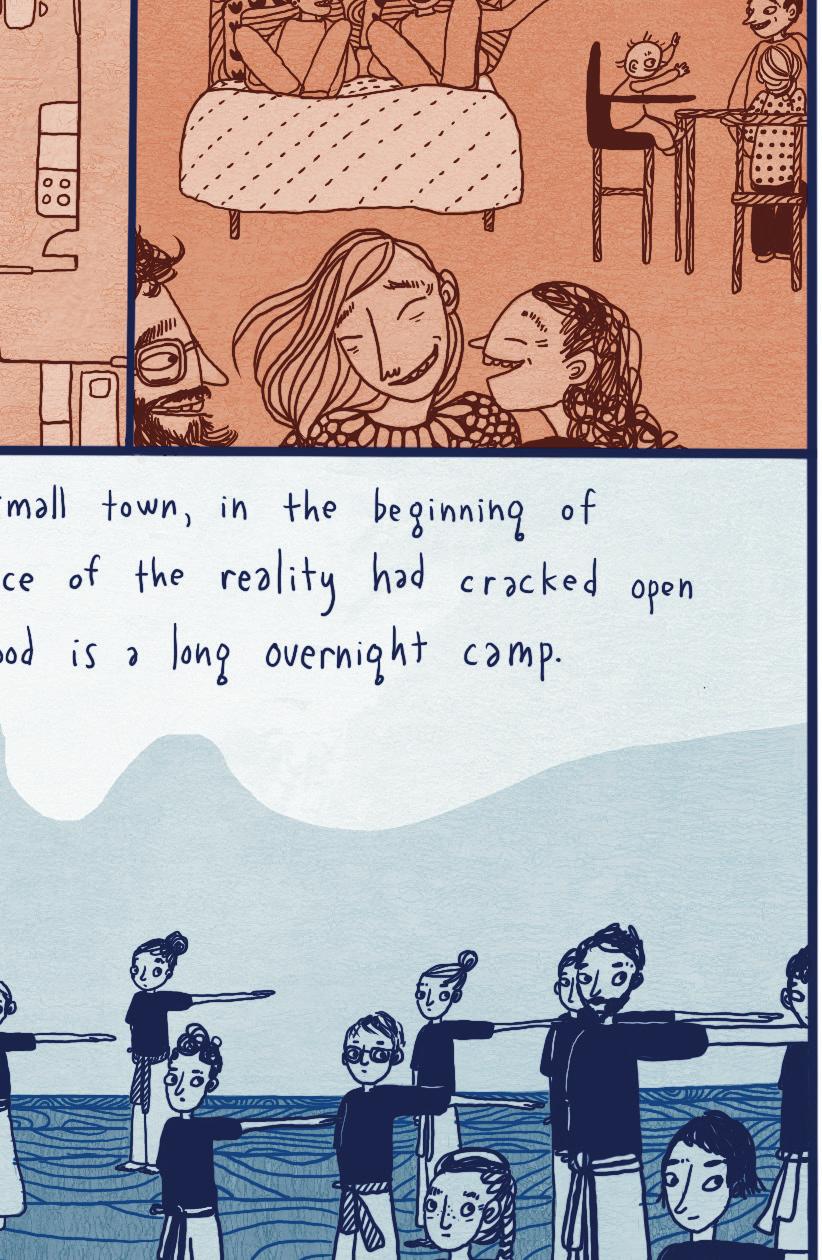

BY JASPER MCGIBNEY, GREEN MOUNTAIN SUMMER JOURNALISM INSTITUTE
The buzz of notifications in a back pocket. A text sent below the desk. A snap. A like.
All these daily interruptions from cellphones will soon disappear for Vermont K-12 students when the state’s bell-to-bell ban on the devices takes e ect in the 2026-27 school year.
And some students are unhappy about it.
“You’re coming in right out of the gate, and you’re expecting that we won’t be able to self-regulate,” said Isa Harrington, a rising 11th grader at South Burlington High School.
For kids, phones are an integral part of life that keeps them connected, Harrington said. “It’s just a part of culture. Everyone has one.”
A few school districts have already instituted phone policies. But with Act 72, which Gov. Phil Scott signed in June, Vermont has become the 29th state to ban or restrict cellphone use in schools.
You’re coming in right out of the gate, and you’re expecting that we won’t be able to self-regulate.
ISA HARRINGTON
Advocates for the ban argue that it’s precisely the ubiquitous presence of the technology that makes the rules necessary. They cite the damaging e ects of excessive social media use on teens and the value of giving them a break from what has become a constant distraction.
Rep. Angela Arsenault (D-Williston), a member of the Vermont Coalition for Phone and Social Media-Free Schools, pushed for the legislation. She said it will compel “what is, for some, a very di cult separation from a product that they have, unfortunately and by design, become addicted to.”
Starting in fall 2026, all schools are required to implement an arrival-to-dismissal policy for personal electronic devices. Policies can make exceptions for cellphone use outlined in a student’s health care plan, individualized education plan or 504 plan, or to comply with federal guidelines for homeless students. The new Vermont law also prohibits schools from communicating directly with students through social media, starting immediately.
In 2024, Harwood Union High School in Duxbury was one of the first Vermont schools to go phone-free. The policy, which requires students to slide their phones in special pouches with magnetic locks during schooltime, created a change in the social climate, administrators and students said.
“I was hanging out with people that I wouldn’t normally” after the ban, said Eliana Buckingham, a 2025 Harwood graduate, who noticed more student interaction across the school. “In the cafeteria, it was louder, more rowdy.”







Some students at Thetford Academy saw similar changes when the Upper Valley independent school went phone-free in the 2024-25 school year, using the same magnetic pouches. “People spent a lot more time talking or finding more wholesome ways to spend their time,” said Isaac Yukica, a 2025 graduate.
The new state legislation will largely standardize cellphone policies across Vermont. Current rules vary widely, not just from school to school but also from classroom to classroom.
At Burlington High School, students are supposed to store their phones in caddies hanging on a door during class time.



“Some teachers don’t care at all,” 10th grader Tegan Bushey said. “Others are very, very strict about it.” Burlington isn’t alone in its patchwork practices, according to students and teachers at other schools. In South Burlington, high school classrooms have storage boxes called “phone homes” for students to place their devices in during lessons, but Harrington, the South Burlington junior, said the practice wasn’t strictly enforced last school year.
Essex High School takes a more relaxed approach. Cellphones go into phone caddies only during class time. Even then, some teachers allow them to remain in backpacks.


Essex High School principal Donald Van Nostrand said students can use phones for educational activities in the classroom. He said he wants students to learn to use them as an educational tool when appropriate.
Some educators, though, said uneven enforcement is problematic. Erin Kranichfeld, an Essex High School teacher, has heard some students express frustration with teachers’ varying practices.
“When there is no consistency across the building, it’s confusing for students,” Kranichfeld said. “There is a lot less emotional engagement with their peers” when students have their devices handy.
Champlain Valley Union High School is implementing a new cellphone ban this coming school year. Students will have to store their phones in envelopes during the school day. Principal Katherine Riley said she hopes to see the positive changes other schools have experienced. “There’s the opportunity to create a different social climate,” she said.
The Vermont Coalition for Phone and Social Media-Free Schools includes educators, students, parents, health care providers, legislators and community members. A representative from the coalition, as well as reps for the Vermont School Boards Association and the Vermont Independent Schools Association, will work with the secretary of education to develop a model policy by January 1. School boards can set their own policies as long as they are at least as strict as the state’s.
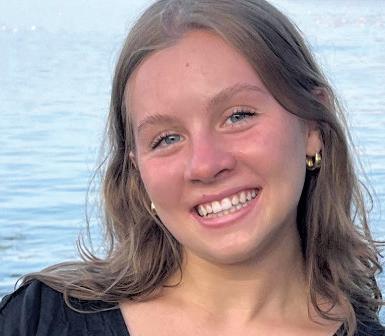

Arsenault, the state representative who supported the ban, was clear about the approach she’d like to see schools take: “Phones should be stored away and inaccessible to students.”
For some students, that level of restriction causes concern. Aidyn Peters-Smith, a South Burlington junior, said she uses her phone to figure out how she and her younger sister will get home after school.
“I don’t like not being able to communicate with other people,” she said.
Peters-Smith added that students should learn to control themselves when it comes to screen use, rather than have controls imposed on them.
“If they have the chance to use their phone and they decide not to do it, I think that’s better than just constantly being forced not to,” she said.
To Yukica, the Thetford policy provides a needed intervention to help students build healthy social media habits.
“People who don’t have their phone throughout the day or for extended periods of time are so much better at regulating their use because they learn not to be dependent on it,” he said.
“Social media is an extremely addictive thing, and it’s not reasonable to expect us to be able to manage that on our own.” K

Jasper McGibney, 16, is a junior at South Burlington High School and writes for his school’s newspaper, the Howling Herald












A teenage back-to-school shopper gets more bang for her bucks at secondhand stores
STORY MARYN KERRIGAN, GREEN MOUNTAIN SUMMER JOURNALISM INSTITUTE | PHOTOS
DARIA BISHOP






ince I was 10, I’ve aspired to be a pro thrifter. I spent weeks researching how to properly scavenge through clothes and imagine the possibilities for what I found. An item may look plain or ugly hanging on the rack until you try it on and style it. When I discover something unexpected and get to express myself with the unique goodies I dig up, I get a natural high.







back-to-school



This summer, I learned from my mom how much she spends on back-to-school clothes for me and my sister: about $600. That’s not unusual. American families are expected to spend an average of $249.36 on back-to-school clothes and accessories for K-12 students. That jumps to $858 on average when including electronics and other school supplies, according to National Retail Federation surveys. Continuing inflation has made it tougher for families to stick to a budget.
$600.










We typically go back-to-school shopping at Kohl’s, Old Navy and Urban Outfitters. I challenged myself to spend a fraction of our typical budget by thrifting.







I headed to local thrift shops with $100 in my wallet to see how much I could cross o my back-to-school list.


My first stop: Dirt Chic on Main Street in downtown Burlington. Inside, the shop smells a little like an old farmhouse in rural Vermont, despite its urban location.





The store’s name is fitting: You can find chic, vintage selections from various decades — the 1960s, ’70s and 2000s — as well as contemporary brands, for a reasonable price. Jeans, sweaters and shirts range from $7 apiece to more than $40 for items from higher-end designers.





“Chic! Chic!” I heard an older woman say as she rifled through women’s tank tops near the front of the store.

I shopped in the company of Toby, a cocker spaniel sporting a worn bandana, who belongs to a former Dirt Chic employee. Another canine consultant, Ember — the o cial store dog — wandered through the

Chic old 1960s, through aisles.

The first item on my list was a pair of jeans. In the denim section, which extends along an entire front wall, I came across a pair of Lucky Brand jeans — my all-time favorite — for only $15.50. Then I found a gorgeous, black-and-white-striped maxi skirt for $9.50 and another flowy knee-length brown skirt with flowers for



item section, along wall,




Among the cardigans, I pulled out a basic thick white sweater perfect for fall. On a nearby rack, I couldn’t resist an adorable, oversize button-up shirt with baby blue and white stripes for $14.50.

It was a good haul, particularly because when you’re thrifting, you can’t predict the selection or whether the things you like will be in your size.


“You can find 20 items for $100 or under, and it would cover your basic needs but, that said, it’s hit or miss,” Anya Huneke, owner of Dirt Chic, told me on a previous visit to the store. “If you don’t find the right item that day, you can come back a week or two later, and you will probably find the right fit.”




$8.50. pulled basic fall. button-up you Chic, the







In

Shalom Shuk provides a few hundred vouchers — worth $20 or $50 — each year to customers in need who request assistance.


Others shoppers can donate money toward the vouchers, which work like gift cards.
“I would absolutely love to see people come in to do their back-to-school shopping. They’d be able to get so much more for their kids,” Kira Plosila, one of Shalom Shuk’s managers, told me one July afternoon. “I was doing the math last night, and even if we don’t do a voucher for them, they could get 20 to 30 outfits for 100 bucks or less, versus, like, three or four at Kohl’s.”

the Shalom Shuk women’s section, I scored a $5 blue cami that matches the brown skirt from Dirt Chic.
At Shalom Shuk, in a small shack behind Ohavi Zedek synagogue on North Prospect Street in Burlington, I figured I could not only get some deals but also help support the community. The congregation donates some of the proceeds from its thrift store to local nonprofits, including COTS, Champlain Valley Office of Economic Opportunity and Howard Center.
Shalom Shuk’s selection varies based on the items people donate. Sometimes, the store gets sports equipment, such as soccer cleats, which can help families who need gear for kids’ extracurricular activities. I still had more tops on my shopping list. In the Shalom Shuk women’s section, I scored a blue cami for $5 that matches the brown skirt from Dirt Chic and a plush gray $8 crew-neck sweatshirt that read “Primrose Hill, London” with a crested lion on the front. I also grabbed a pale gray shirt with a meadow scene and a simple grayand-white striped T-shirt for $5 each.


My final stop was ReSOURCE, on Pine Street in the South End of Burlington. I first heard about the store from my mom’s boyfriend and a close friend of mine. I wouldn’t have known it was a thrift store from the outside.

The location looks like a warehouse, with men in neon construction uniforms with yellow hard hats scouring for materials outside. Inside, it has everything you can imagine: jewelry, fine china, antique books, tools and electronics of all kinds.
Amid all that is the clothing section, a thrifter’s dream, with rack upon rack of items. Signs taped to the racks and mirrors read, “ALL CLOTHES AND SHOES ARE $2 UNLESS MARKED OTHERWISE.”

“We get so many clothes that we can bulk price it like that,” ReSOURCE manager Chris Dusablon said. “We do tag some higher-end things if we find it necessary, like a $5 jacket here and there, but it’s mostly always under 10 or 20 bucks.” Belts, ties and hats are $1 each.
ReSOURCE also has a back-to-school section near the front register that includes backpacks, paper, pens and pencils for a dollar or two — unheard of in other stores.
I beelined it to a pair of shorts that will go with almost any top in my wardrobe. Then, I found a perfect pair of dark denim, boot-cut jeans that I’ve always coveted. I expected both might be a little big on me, and there were no fitting rooms to try them, but I had a belt at home that I had thrifted earlier in the summer that would solve that problem.
In the spur of the moment, I grabbed an adorable pair of black Keds sneakers o the shoe rack. I also picked up three sweaters to wear with the jeans and a simple brown ribbed top to fill the gaps in my T-shirt drawer. Each item was just $2.
With visits to those three stores, I took care of most of my needs and spent just $94.50. I was blown away by the bang I got for my bucks — which, of course, is the beauty of thrifting. K
Maryn Kerrigan, 16, is a sophomore at Burlington High School and enjoys writing.










TOTAL SPENT: $94.50
DIRT CHIC







67 Main St., Burlington, dirtchicvt.com






SHALOM SHUK


188 No. Prospect St., Burlington, ohavizedek.org



RESOURCE
, , , 339 Pine St.,





339 Pine St., Burlington, resourcevt.org





BY LILY GRUBER, GREEN MOUNTAIN SUMMER JOURNALISM INSTITUTE
Annalise Wood applied to work at 18 businesses this spring before finally landing a job as a cashier at Shelburne Market in July. The 18-yearold Hinesburg resident, who will attend Bates College in Maine this fall, hoped to get work experience and save some money for college.
Most days, she checks out customers at the register and sometimes gets to restock shelves, which she considers a “special treat.”
As a teen still living at home, she has to work around the activities and vacations her parents plan, which can complicate scheduling. Her boss is understanding that she needs flexibility in her work hours, Wood said.
As a young employee, “not everything is in our control,” she said. “If you’re going to be gone, you don’t really have a choice.”
Teens play a significant role in the Vermont workforce — as retail employees, restaurant servers and counter staff. Among Vermonters ages 16 to 19, almost 53 percent have jobs, according to the U.S. Census Bureau. Vermont has the thirdhighest percentage of teens participating in the labor force among the 39 states that include this age bracket in data for the U.S. Bureau of Labor Statistics. Minnesota ranks first with 57 percent of 16- to 19-year-olds employed, and California comes in last with about 22 percent.
Yet some teens surveyed for this article said they feel like they aren’t treated the same way as older colleagues. Their earnings are often at the low end of the pay scale, which went from $13.67 to $14.01 an hour in January, when the state increased the minimum wage. That might be partly because, in addition to learning job skills, they’re also figuring out for the first time how to negotiate raises, manage scheduling conflicts and navigate challenges with coworkers.
Nora Bolton works as a floor lead for Plato’s Closet in Williston. When her manager is away, she takes charge of directing staff and assigning tasks. With about two and a half years on the job, Bolton, who is 16 and lives in South Burlington, is one of the secondhandclothing store’s longest-serving employees. Because of this, she was promoted to her current position about a year ago. Sometimes, she said, she finds it a little awkward to oversee older coworkers.
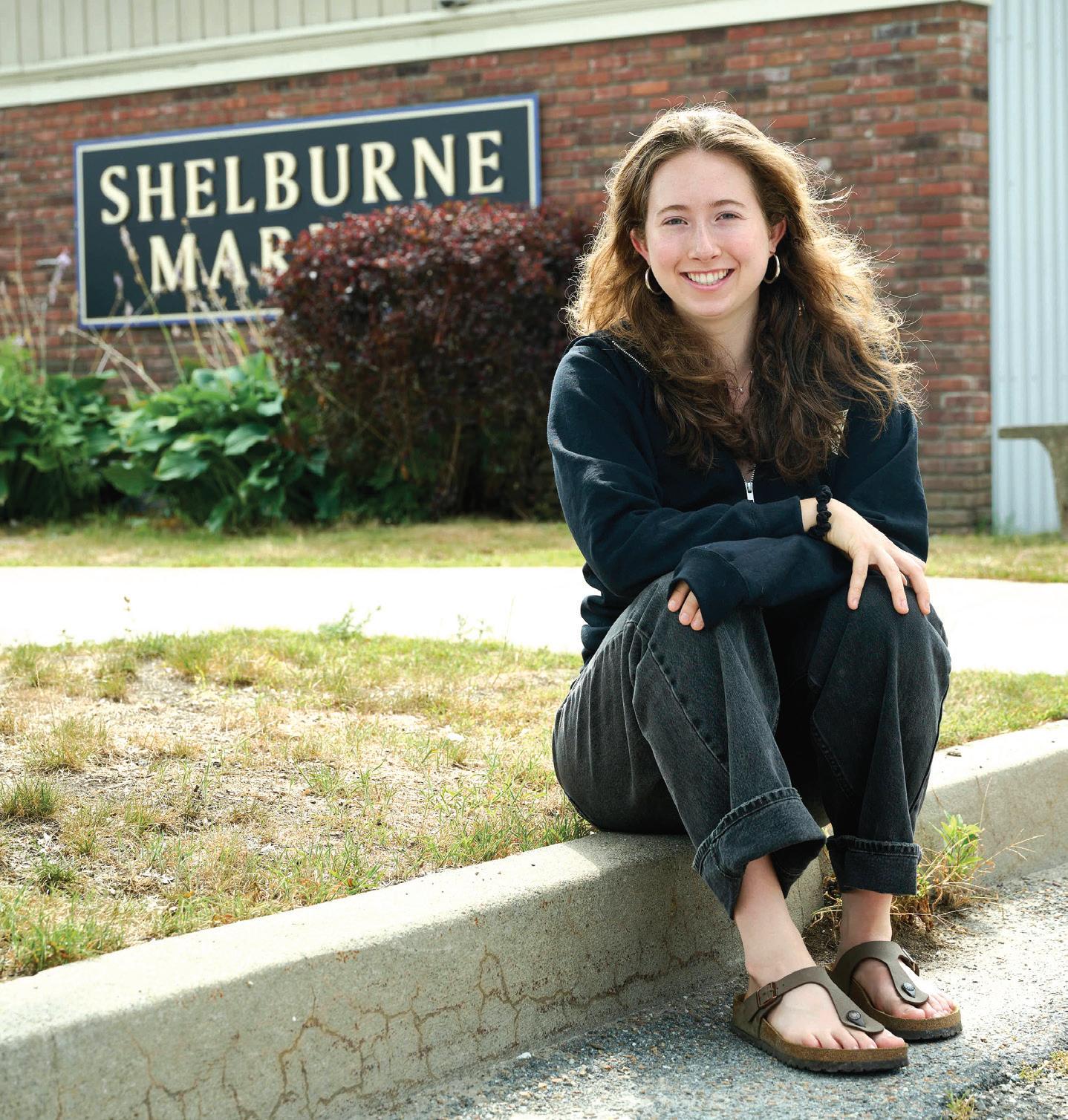
“They don’t listen to a 16-year-old girl, and that can be frustrating sometimes,” Bolton said.
Bolton puts her earnings toward clothes and shoes and upkeep for her car, she said. She recently realized that she
You’re not just training someone to do this job. You’re often training them to do their first job.
DAWN WAGNER
was paid less than the amount that Plato’s Closet is advertising for new workers. She asked her boss for a raise and got a small bump. A new, older coworker makes about the same wage Bolton does, despite having less experience, she said.
Samantha Bradley, 17, a pizza maker at Cucina Antica Bistro in Shelburne,
started working at the restaurant two years ago to help pay for gas and other car expenses. Her mom doesn’t own a car, so Bradley uses hers to run errands, drive to school and work, and stay at her dad’s in Leicester, about an hour away from her mom in South Burlington.
Bradley made $13.18 an hour in 2023 and got a raise last year to $15 an hour. Starting workers at Cucina Antica earn Vermont’s minimum wage. Most of her coworkers are fellow high school students, she said.
At many restaurants today, tips go into a pool for distribution among all staff, but at Cucina Antica, only “front-of-house” employees, such as servers, earn tips, Bradley said. The owner, she added, is a little “old-fashioned” and pays workers by paper check, not direct deposit.
Not all local employers have found that hiring high school students works for them. Linda Cook, owner of Linda’s Apparel in Vergennes, said she had trouble with student employees’
reliability and with scheduling those who had commitments on sports teams. Once she hired a teen who didn’t know how to use a vacuum cleaner.
“Kids just don’t seem to want to work the way they used to,” Cook said from behind the register at her shop. “They want to be on their phones.”
At Daily Chocolate in Vergennes, owner Dawn Wagner has hired two students since she opened the shop five years ago. Every year, about five to 10 of them apply to work there, but scheduling is a challenge. Once school starts, students aren’t free until 3:30. “I’m closed at four,” she said.
Some teens can only work one weekend day, but these inexperienced employees also need time to learn on the job, and their limited availability is sometimes “inefficient,” Wagner said.
“You’re not just training someone to do this job. You’re often training them to do their first job,” Wagner said as she cut into a large block of chocolate on her shop counter.
“It’s one thing to teach the procedures of the business. It’s another thing to teach someone to make eye contact, to say hello, to make change, to figure out when someone’s ready to be waited on.”
Chloe Speyers said she has had great experiences with teen workers at Haymaker Bun, where she is general manager of both the Middlebury and Burlington locations. The job allows them to practice customer service skills that they can use later in life, she said.
“Learning how to understand and talk to people is a huge part of working in the food-service industry, particularly in the front of the house,” Speyers said.
At the same time, they share the latest details of their lives and what’s happening in their communities, she said. One teen baker has worked for Haymaker Bun for more than four years.
“It’s been so amazing to watch her grow,” Speyers said. “It’s really rewarding to have been part of her high school experience.” K

Lily Gruber, 17, is a senior at Champlain Valley Union High School and a writer/co-managing editor of the Hawks’ Nest, the school newspaper.




















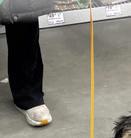




























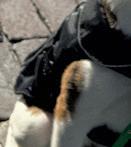



















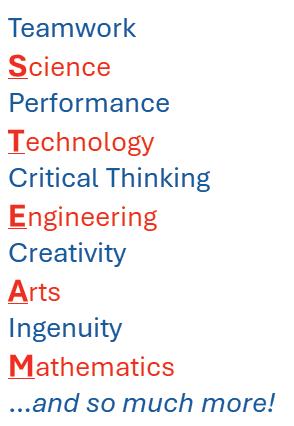





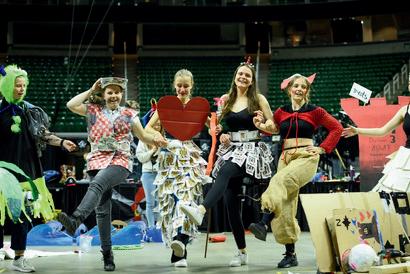









Young Vermonters talk about how they learned to hunt and why they love it
STORY TATUM KIRTLINK, GREEN MOUNTAIN SUMMER JOURNALISM INSTITUTE | PHOTOS OWEN LEAVEY
Young Vermont hunters need a few pointers before they pick up a rifle and pursue a 10-point buck.
They first have to qualify for a license. The state requires that they complete a hunter education course to learn how to safely handle a firearm, interact with an outdoor environment, and follow hunting laws and ethics. There is no minimum age requirement, but students under 16 need parental permission.
Once they finish the course, they earn an orange card — a certificate that allows the hunter to get a license. Then, they can start chasing game. And young hunters can get a head start on the adults if they want to go after turkeys or deer during youth weekends in the spring and fall, a couple of weeks before the start of the regular hunting seasons.
I would rather see kids out fishing and hunting than playing a video game.
TYLER MITCHELL
Tyler Mitchell has taught hunter education for the Vermont Fish & Wildlife Department in Williamstown. He covers firearm safety, including safe storage and muzzle control, so hunters don’t accidentally fire their guns. Mitchell said he always appreciates the chance to get young people interested in Vermont’s outdoors and its hunting and fishing programs.
“I would rather see kids out fishing and hunting than playing a video game,” Mitchell said.
One learning experience for would-be young hunters is the Green Mountain Conservation Camp, a yearly summer session run by the Vermont Fish & Wildlife Department. Kids ages 12 to 16 participate in hands-on activities that teach firearm safety, outdoor first aid and lessons about local wildlife.
Macy Macbeth, 16, and Leila Macbeth, 14, are sisters from Milton who started hunting a few years ago. Both attended the Green Mountain Conservation Camp. Tatum Kirtlink, reporting for Kids VT as part of the Green Mountain Summer Journalism Institute, is also an avid
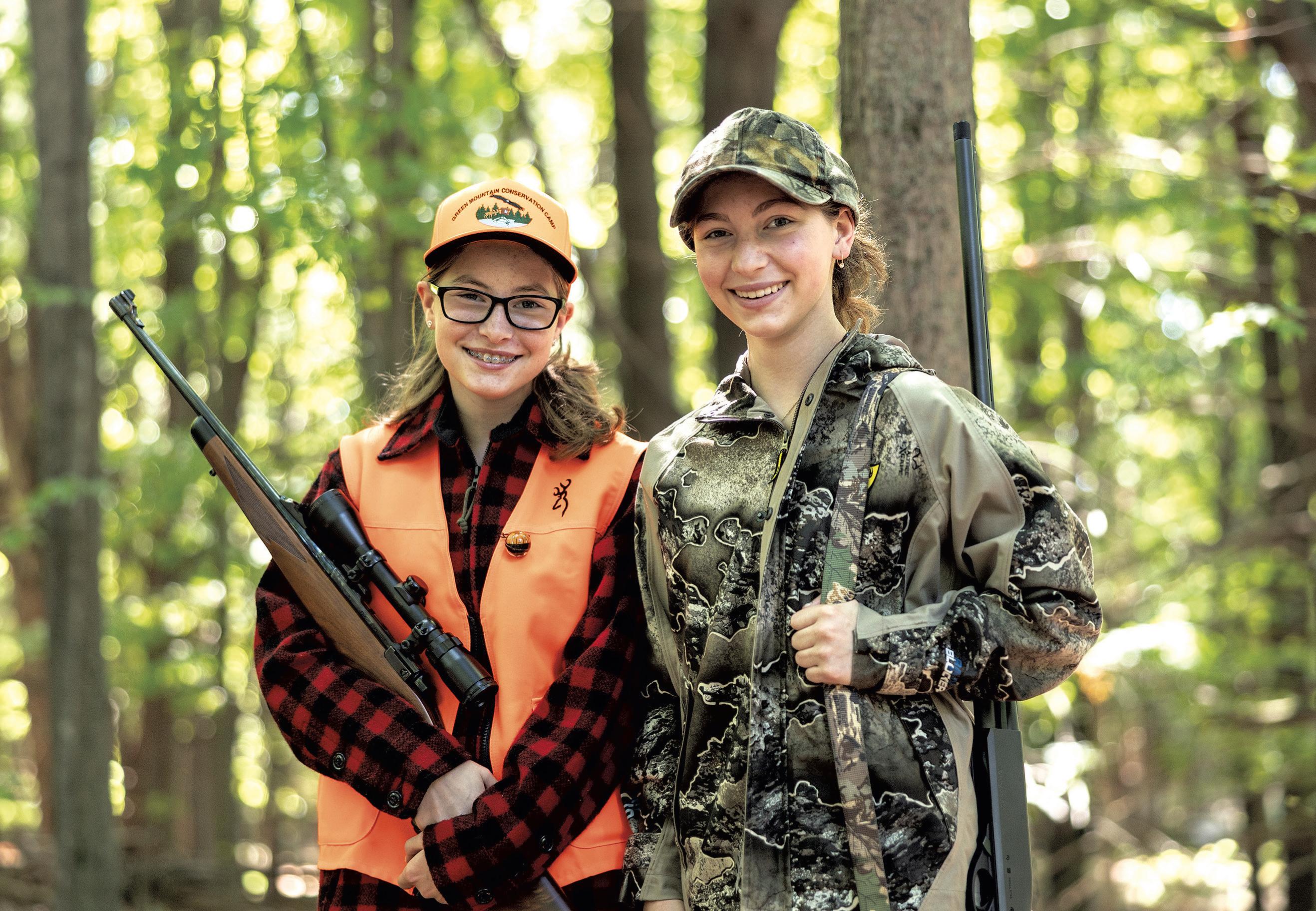
hunter and talked with the Macbeth sisters about their love of the woods and their advice for young hunters.
What got you into hunting?
MACY: Our dad is a really big hunter, and when we were younger, he would always take us out in the woods with him. And that was always a really fun thing to do.
That’s the same exact way I got into it.
LEILA: For me, being the youngest and watching Macy go out hunting, not always coming back with something or just going out for fun, helped me see that it’s not about getting something, so it helped me get into it.
I still forget that it’s just for fun and I don’t need to bring any game home. On that note, has there been a time when you wanted to give up on hunting?
LEILA: I don’t know why, but there was one time we went out and didn’t see anything, but it was really miserable
because it was raining a lot, so that made me want to stop. But it was just one time.
I’ve been there. I just want to go back to bed instead of sitting in the rain.
MACY: Yeah? Well, lucky for her, she can just sleep in the hunting shack. I do it all the time.
What’s your best memory of hunting or proudest moment?
MACY: It was when I shot my first squirrel. I had just come home from school in fifth grade. I was still in my school clothes, and I went up in the woods with my dad. He was trying to show me how to do stuff. I was like, “Let me just do it on my own.” I had my eye on this one squirrel, and I got them all on my own, and it just made me really happy.
LEILA: My proudest moment was when I got my deer. I had only been up in the woods for about six hours, and we saw it come into our food plot that

we put time into, which also made me really happy. But for me, it was a hard decision, thinking that I would be the one responsible for taking a life. When I
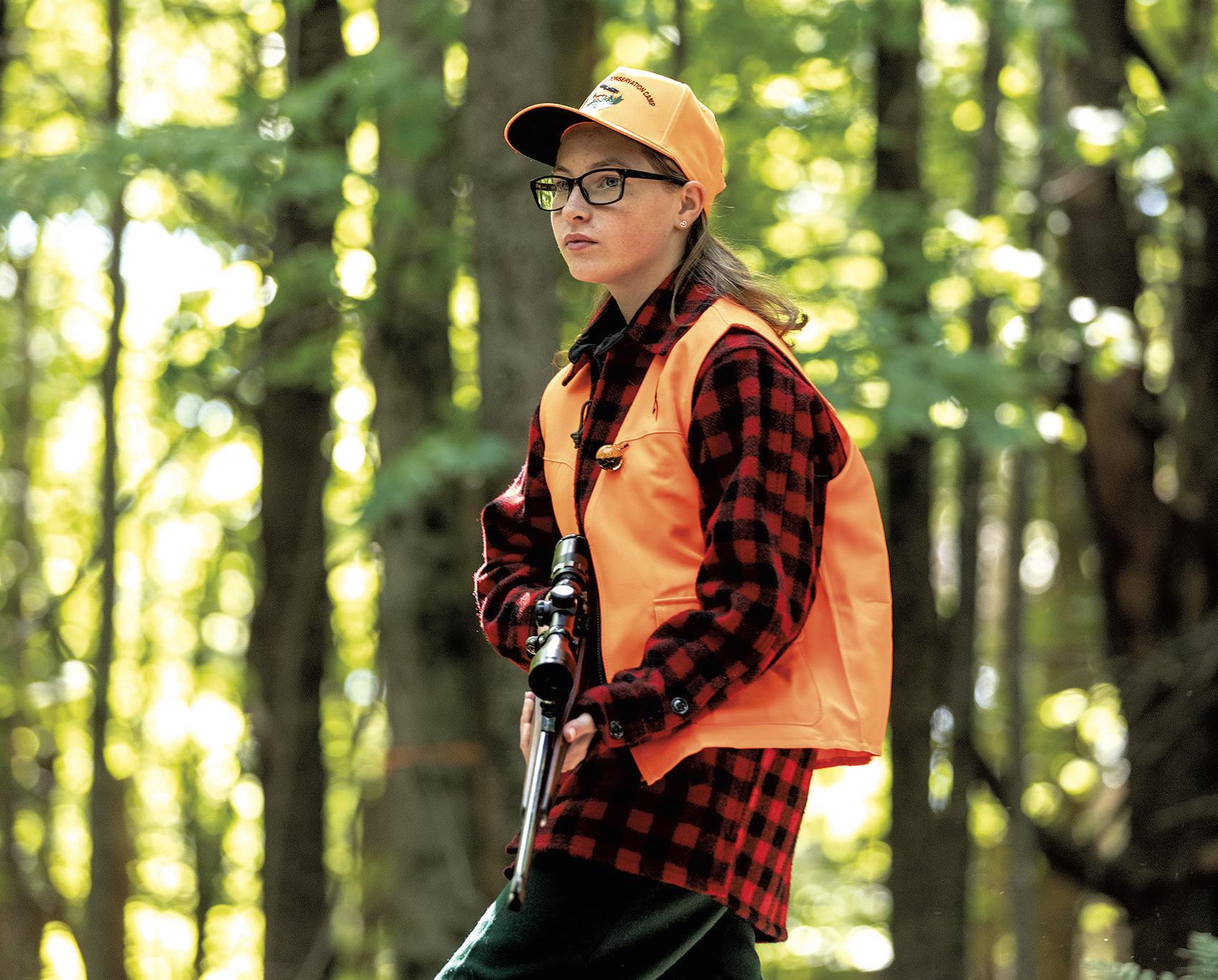
pulled the trigger, I just collapsed into a puddle of tears, and then we went and tracked the deer. It was a clean shot, so it was dead right away. It only went a couple yards, but that was my proudest moment, knowing that I did a good job of taking a life.
It’s definitely something that’s a little nerve-racking when you first get into it. I’ve been hunting for four years, and I only just took my first shot and missed it. I was very disappointed.
MACY: I’ve taken a lot of shots and missed a lot of them. It doesn’t get easier. When I got my turkey, I’d had my eye on him for forever, and somebody was in our spot, so we had to go find a different spot on the fly. Right after moving, we heard a shot. I was so disappointed, because I thought somebody else must have just gotten my bird, but he was still alive. We called him up, and I almost blew it because I got too excited, but I was able to bag him. I was really happy.
What has hunting taught you?
MACY: Good things come to those who wait. Truly, truly, truly, it does. You know, Leila has been going out with Dad for longer than I have, [even before she started hunting,] so she’s done her fair share of time in the woods. It’s all just about patience and waiting for the right moment.
LEILA: I used to be terrible at waiting patiently, but hunting has taught me a lot of patience and always keeping a positive mind.

















When you started hunting, what are some things or people that helped you?

MACY: dad and my grandfather, who is even bigger into hunting, and he’s done all of these things and gone to all these places to hunt. It’s just him teaching us all of his little tips and tricks. Then, of course, just going out and having fun with friends, too.






If someone is interested in getting into hunting, what would you recommend?
MACY: I would say definitely look into Green Mountain Conservation Camp. Definitely try to do a week there.
LEILA: I second that.
MACY: That was the biggest thing: Take a professional class. I mean, you have to to get your license anyway, but take it. Make the most of it. Get in touch with somebody who is willing to help you out the first couple times. Talk to your neighbors, talk to farmers. Try to find some places that you are able to hunt, like season to season, and just have fun with it. K
This interview has been edited for clarity and length.

Tatum Kirtlink, 15, is a sophomore at Montpelier High School and photographs for their school paper, the Solon Spectrum




















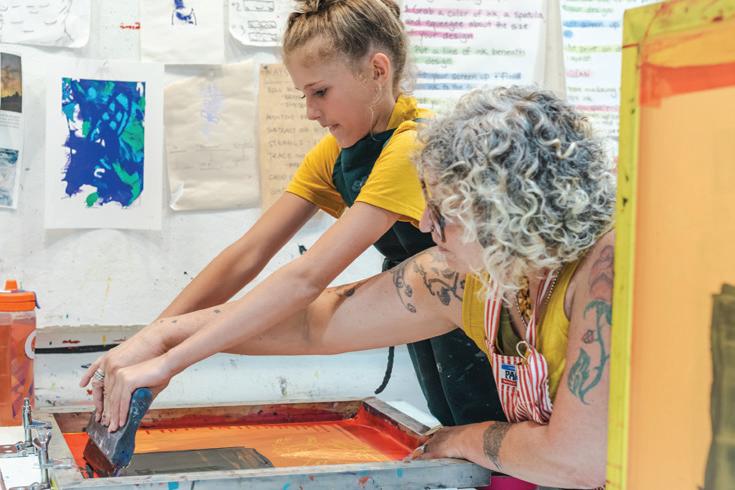






BY LEILA DUMONT, GREEN MOUNTAIN
When Milton’s Connor Eaton was growing up, he and his grandfather, John Cushing, shared a love of woodworking and made several birdhouses together. So when Cushing was diagnosed with dementia caused by Lewy body disease and his cognition started to deteriorate, Eaton, now 16, decided to work with him on more birdhouses.
They made one for “Moments in Time,” an exhibition of artwork by Vermonters who have Alzheimer’s disease and other forms of dementia, part of a program curated by the Vermont chapter of the Alzheimer’s Association. Their birdhouse in the “Moments” gallery is shaped like the state of Vermont, with the ridges on the sides smoothed over and a small hole with a perch, where they placed a decorative red cardinal.






“We definitely had a close connection throughout my entire life, yet this still brought us closer than ever before,” Eaton said.
The birdhouses they created together still hang in the Eaton family’s home. Cushing, who also lived in Milton, died in December.
“He always wanted to make birdhouses,” Eaton said. When they installed them outside, “the birds seemed to like them, so we just made more.”
Because of their personal experience with the disease, Eaton and his mom, Sheila Eaton, 51, have helped fundraise for the Alzheimer’s Association. In addition to participating in the “Moments in Time” program, they plan to attend the 2025 Walk to End Alzheimer’s on Sunday, September 28, at the Shelburne Museum.
Formerly known as the Alzheimer’s Memory Walk, the event started in 1989 in locations across the U.S. The Alzheimer’s Association in Vermont hosts three walks: in Rutland, St. Johnsbury and Shelburne. The Shelburne event alone typically surpasses 800 attendees.
According to the Alzheimer’s Association, 13,000 people aged 65 and older are living with the disease in Vermont — and they benefit from spending time with young people. The group’s staffers say more kids are participating in the association’s programs and events these days, helping to spread awareness of efforts to
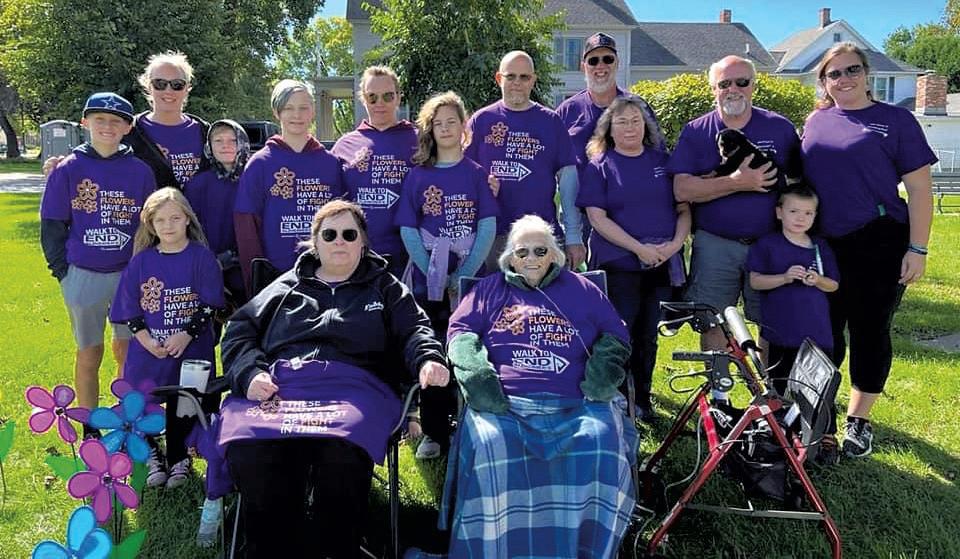
“This is something that they can feel involved with and feel like they’re doing something for their loved one.”
At Stafford’s first school assembly in the fall, Connor and the students begin preparing for the Rutland walk, which falls this year on Saturday, September 27. Teachers at the school promote the fundraiser in their classrooms, Connor said. “We’re still trying to get students to understand [that] something small that you can do could have a big impact.”
destigmatize Alzheimer’s and empower those impacted by it.
“We have seen an increase in the younger generation being more involved in talking about Alzheimer’s and dementia and their connections [to it], whether it’s their grandparents or maybe it’s their friend’s grandparents,” said Jenna Johnson, development manager for the Alzheimer’s Association’s Vermont chapter.
Melissa Connor, 53, director of Stafford Technical Center in Rutland, brings a group of the center’s high school students to the Walk to End Alzheimer’s in Rutland every year. The first year, in 2023, about a dozen students attended, and the number has grown since, Connor said.
What was once just her personal connection to the disease has turned into a community service opportunity for many students in the school, said Connor, who lives in Mount Holly. “One of the cornerstones here at Stafford is [showing] the students different ways that they can get involved with their community,” she said.
When young people get involved, Johnson said, they foster a connection with their elders.
“Alzheimer’s and dementia impacts whole families, so I think people use the walk and our fundraising, our community events, as ways to come together,” she said.
Sheila Eaton saw the connection between her son and father flourish when she watched them working on the birdhouse for “Moments in Time.” “Dad was just absolutely in awe” when he saw the progress they made with every step, she said. “So it was nice to see them doing something that they loved together.” K
Find more information about the walks and the Vermont chapter of the Alzheimer’s Association at alz.org/vermont.

Leila duMont, 16, is a junior at Rice Memorial High School. She loves to write and perform in theater productions. Her Grammy, Jessie duMont, died from Alzheimer’s in 2018 and inspired her granddaughter’s interest in this story.
Three winners will each receive a gift card to a local bookstore. Send Kids VT your work of art by October 24 Be sure to include the info at right with your submission. Winners will be chosen in the following categories: (1) ages 5 and younger, (2) ages 6-8 and (3) ages 9-12. Winners will be named in the Winter Issue of Kids VT. Send your high-resolution scans to art@kidsvt.com or mail a copy to Kids VT, P.O. Box 1164, Burlington, VT 05401.

















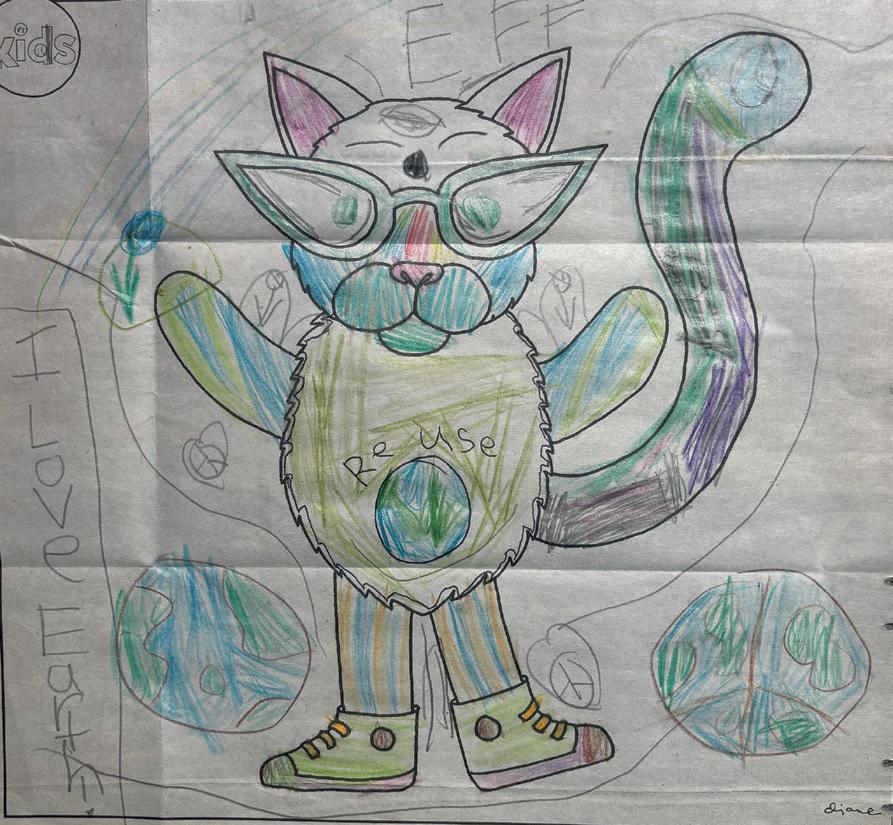
“Planet of Life”
Willow Keighley, 5 BOLTON
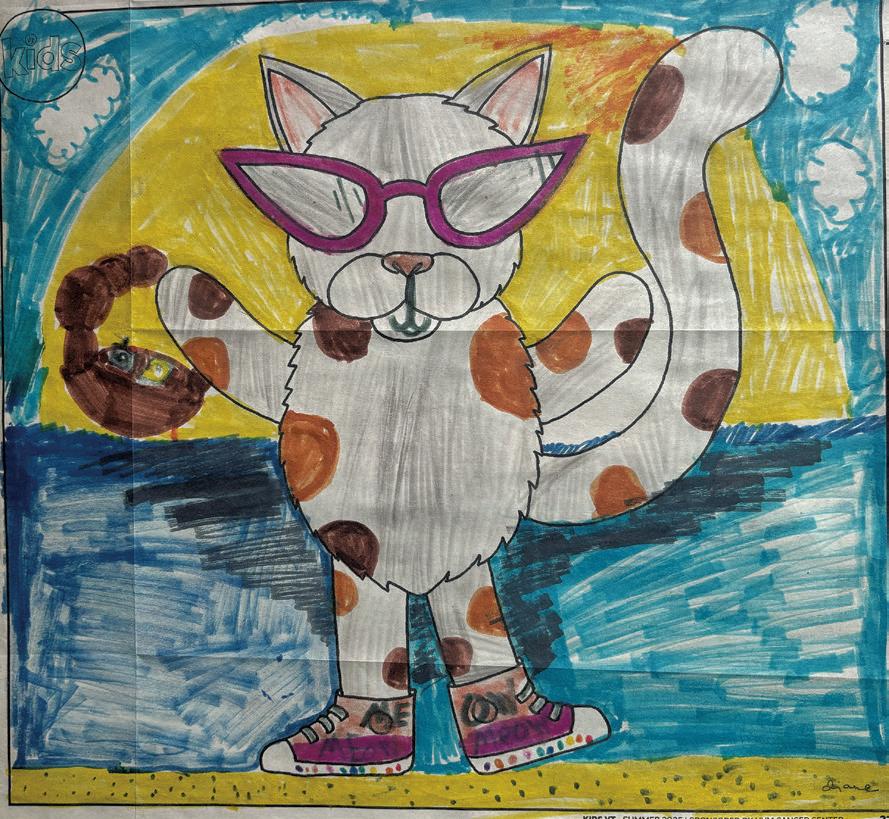



9 to 12
“Sunny Side Cat” McKinley Charest, 8 BOLTON

5 & under



We received lots of cool cats in the mail and in our inbox for the summer coloring contest. The kitties at the beach were purr-fect for the season, and the festive feline dance parties made us want to boogie down, too. Thanks to everyone who shared their artwork. We can’t wait to see what you send us next!


I’M A FANTASY
Willow Pfeil, 11, Richmond
SLAY, KITTY, SLAY
Juniper Juno Howell, 10, Burlington
SPIDER-CAT
Miguel Santana, 10, Montpelier
TYE DYE SPRING AND SUMMER
Edith Ingalls-Fairweather, 12, Waterville
PRIDE CAT
Bridget Williams, 10, Moretown

6 to 8



These winners receive a sun protection kit from the UVM Cancer Center
FIRE & ICE
CAT OF DECISION
VT GREEN SUPER FAN

Alder Ingalls-Fairweather, 10, Waterville
Ari Anast, 9, Shelburne
Paige Tilton, 11, Underhill
DANCE PARTY
Landon Plante, 8, Fairfax
ELLEN ON STAGE Weezy, 8, Vergennes
DAY AT THE BEACH
Juliet D, 7, Shelburne




“Black & White & Cute All Over” Oona Raven, 11 WOODBURY
TAILS
Clem Cobb, 5, Montpelier
MR. COOL Nico, 5, Essex
MEOW-Y
Althea Decatur, 3, Fairfax
VIOLET THE CAT
Rosie Desisto, 5, Burlington
KITTY RAINBOW
Nova Ferris, 4, Jericho
KOOL KAT
Winter Prentiss, 8, Woodbury
BY ANTHONY CINQUINA
Visiting a town clerk’s o ce. Designing a new “Future Voter” sticker. Picking up trash on a local trail. These are some of the 25 activities in this summer’s Good Citizen Challenge, a youth civics project aimed at building a new generation of active, engaged citizens.
Organized by Kids VT and Seven Days — with support from the Vermont Community Foundation — the Challenge invites kids in kindergarten through grade 8 to do some or all of these activities, then upload the evidence to the Good Citizen website. So far this summer, we’ve received nearly 800 entries from students across the state, from Richmond to Newfane, Montpelier to Middlebury, Burlington to Brandon and South Hero to Stowe. Some are part of summer camps or classes, some go it alone, and others do the Challenge with friends and family.
Every Thursday, one of these participants wins a $50 Phoenix Books gift card — we ra e it o on “Channel 3 This Morning.” And one lucky winner will enjoy a free trip for two to Washington, D.C.!
Here are a few notable submissions from our 2025 Hall of Fame. Find more, along with a list of activities and a submission form, at goodcitizenvt. com. There’s still time to enter as of press time — the deadline is Labor Day, September 1. K

FRANKIE HOUGHTON, 8, of Middlebury completed activity No. 5 when she jumped into the Middlebury Town Pool. This incredible action shot of Frankie — taken by her grandfather, Steve James — made it in the Addison County Independent’s “photos of the week” section!
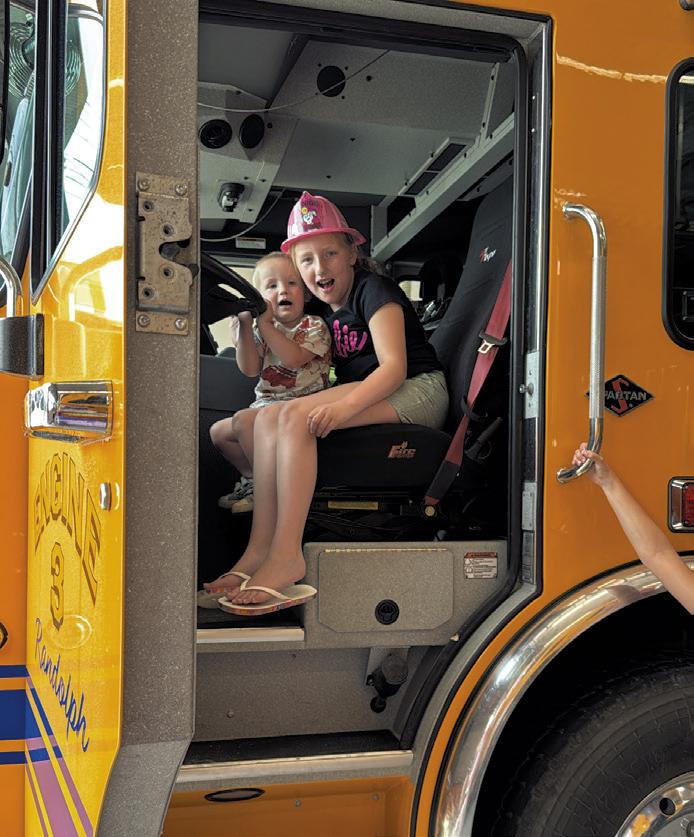
PIPER BLANCHARD, 9, of Randolph completed activity No. 7 by visiting her local fire department. Piper got to sit in a fire truck and learned all about how the department works. “[It’s] a volunteer fire department,” Piper said. “The firefighters don’t sleep there. They have to drive to the station when a call comes in.”
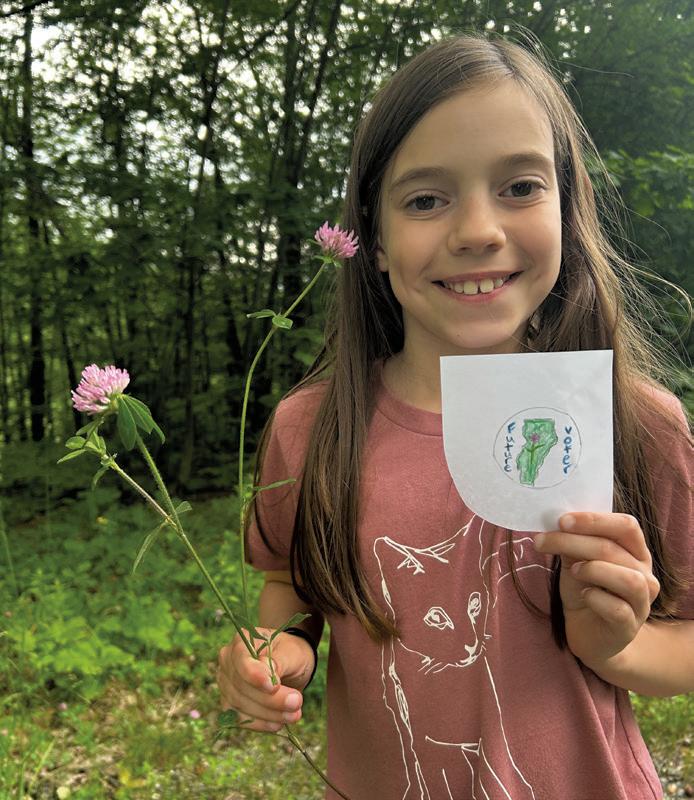
ELLA BROWN, 9, of Newfane completed activity No. 1 after she created her very own new “Future Voter” sticker. “I drew the shape of Vermont with a red clover inside (state flower) and blue ‘future voter’ on the sides,” she said.
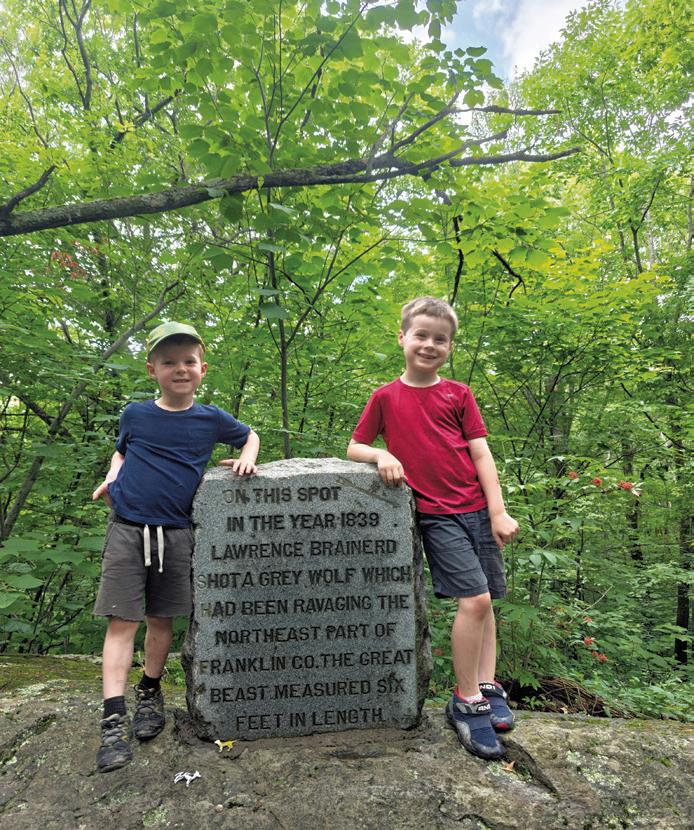
BRENNAN AND JOHN PAUL BROUCHARD of Sheldon, ages 5 and 8, completed activity No. 3 by visiting Wolf Monument at the top of Aldis Hill in St. Albans. The monument commemorates local politician Lawrence Brainerd’s successful hunt of a large gray wolf that had been ravaging Franklin County.

OLLIE GRANT, 7, of Burlington completed activity No. 13, Organize Support for a Cause, when he raised $25 for the humane society by running his very own lemonade stand. Ollie (pictured here with siblings) even delivered the money himself!


RUSSELL LOCKE, 7, of Johnson went above and beyond in completing activity No. 21, Watch or Listen to the Local News, by viewing WCAX-TV’s noon newscast from the studio. Russell got a tour from vice president Jay Barton, met reporter Ike Bendavid and even got to participate in a weather forecast. “I learned that it takes a lot of time to actually make the news,” Russell said. “It’s also very complex!”
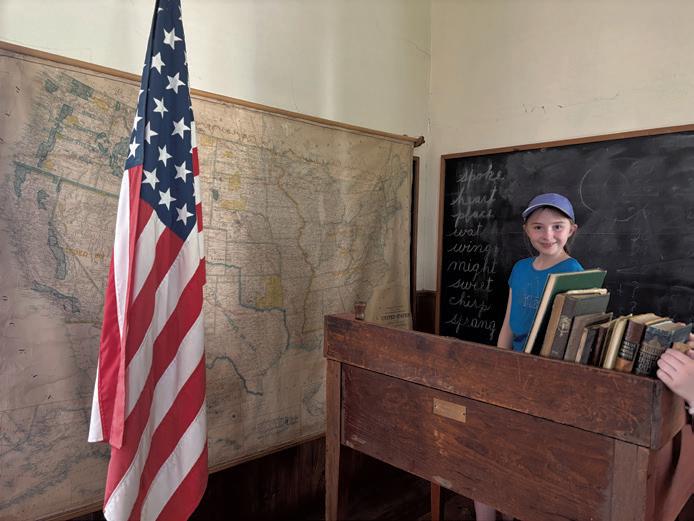
AMELIA DABRITZ, 11, of Burlington completed activity No. 16 by visiting Stowe’s Bloody Brook Schoolhouse and learning about its history. “It was fun to see how people in the olden days used to go to school,” Amelia said. “I liked learning that they voted on how long the school year is. One year it was three months of school in the fall and three months in the spring.”
Anthony Cinquina is a student at Middlebury College and a Good Citizen Challenge summer 2025 intern.

Financial literacy is an important part of your child’s education. A Student Checking account, specifically for 13-17 year olds, can assist them in developing responsible habits today to ensure that they make sound financial decisions tomorrow.
No fees or minimums*
Debit card
Parent or guardian is joint on the account
ATM Access
Online & Mobile Banking
Automatically converts into Reward Checking account at age 18




*No monthly service or overdraft fees and no minimum balance requirement. Must be a member of the credit union to open a student checking account.